Your cart is currently empty!
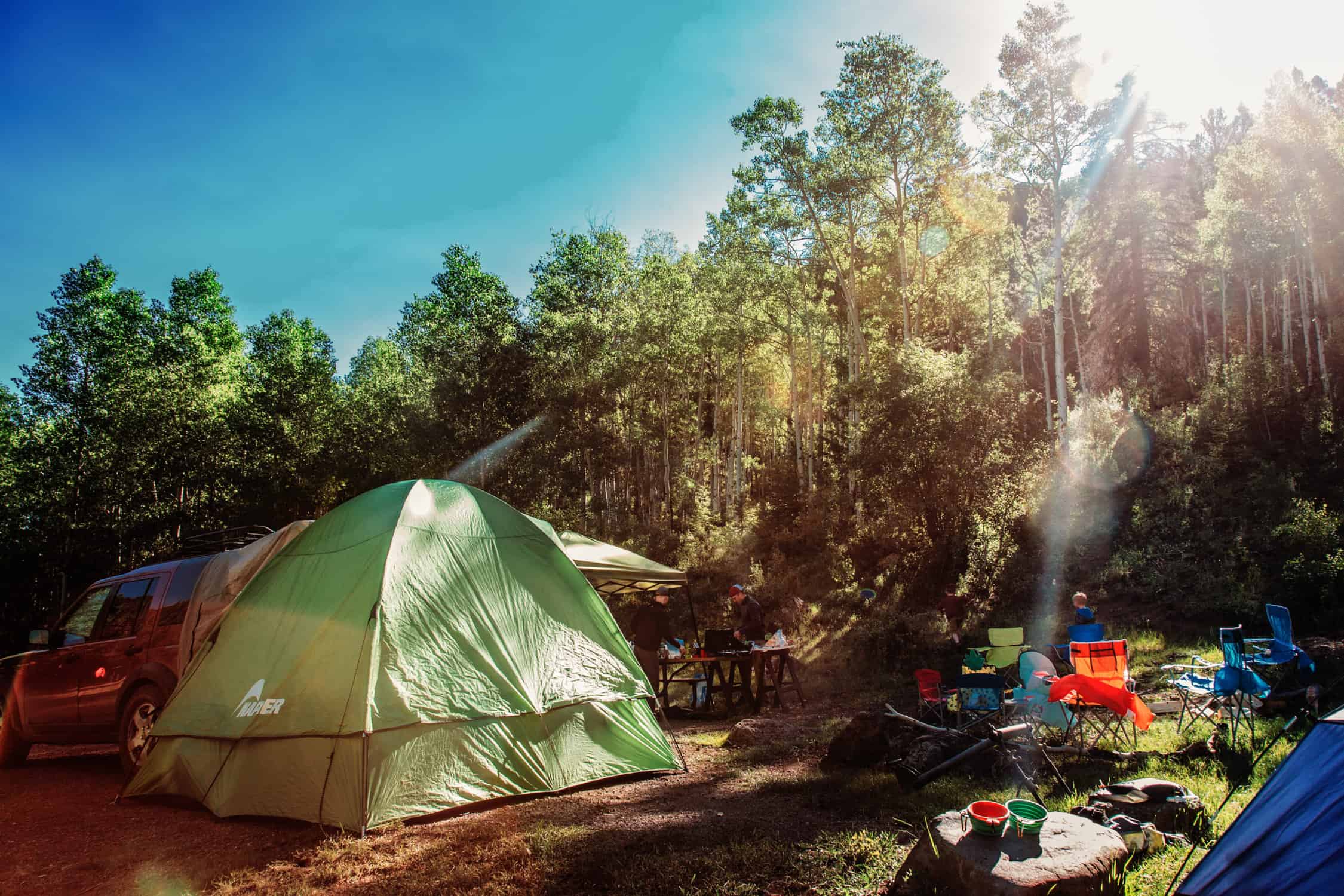
Ultimate Camping Gear List for Families
Packing for a camping trip with the family sounds a bit overwhelming and intimidating. But it doesn’t have to be! Today, Lissy Perna, Cape Cod mom of 2, put together this ultimate family camping gear checklist to help make packing for your next trip quick and easy! She covers everything from the camping essentials to all those little items that are easy to overlook. This printable camping gear packing list for your family is organized by categories and filled with exactly what families need. It’s a great starting point for making your own checklist with absolutely everything you need to make your camping trip a success! We’ve also included some additional resources on finding affordable camping gear, what you specifically need with camping with babies and toddlers (or if you’re bringing your dog), plus tips on how to properly store your camping gear, and more!
*This post contains affiliate links.
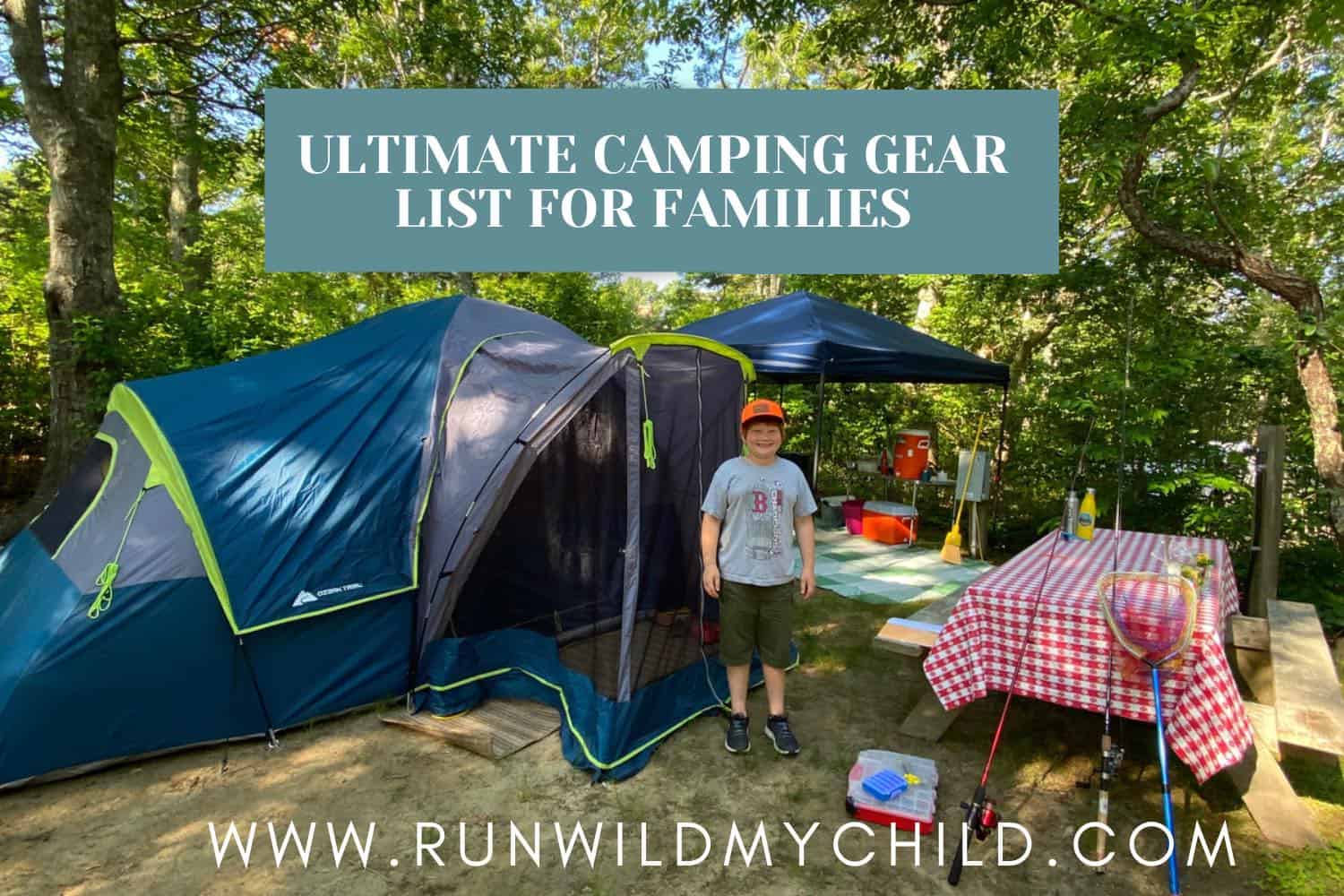
Ultimate camping gear list for families
Is a camping trip with your family on your summer bucket list? Are you planning to visit one of the national parks or even just a small-town campground? Camping is an amazing outdoor experience for the whole family and totally worth all the work. (Yes, it’s work.) It’s easy to get overwhelmed when you start thinking about everything you need to bring when camping with kids. But don’t worry, we’re here to help!
Let this post filled with family camping essentials and our downloadable ultimate family camping gear list be your guide! Whether you’re a camping expert or a camping newbie, having a list is a great way to stay organized and not forget any important items and start making some family memories! We’ll help you get started making your family camping packing list with everything you need to have a fun and well-stocked experience!
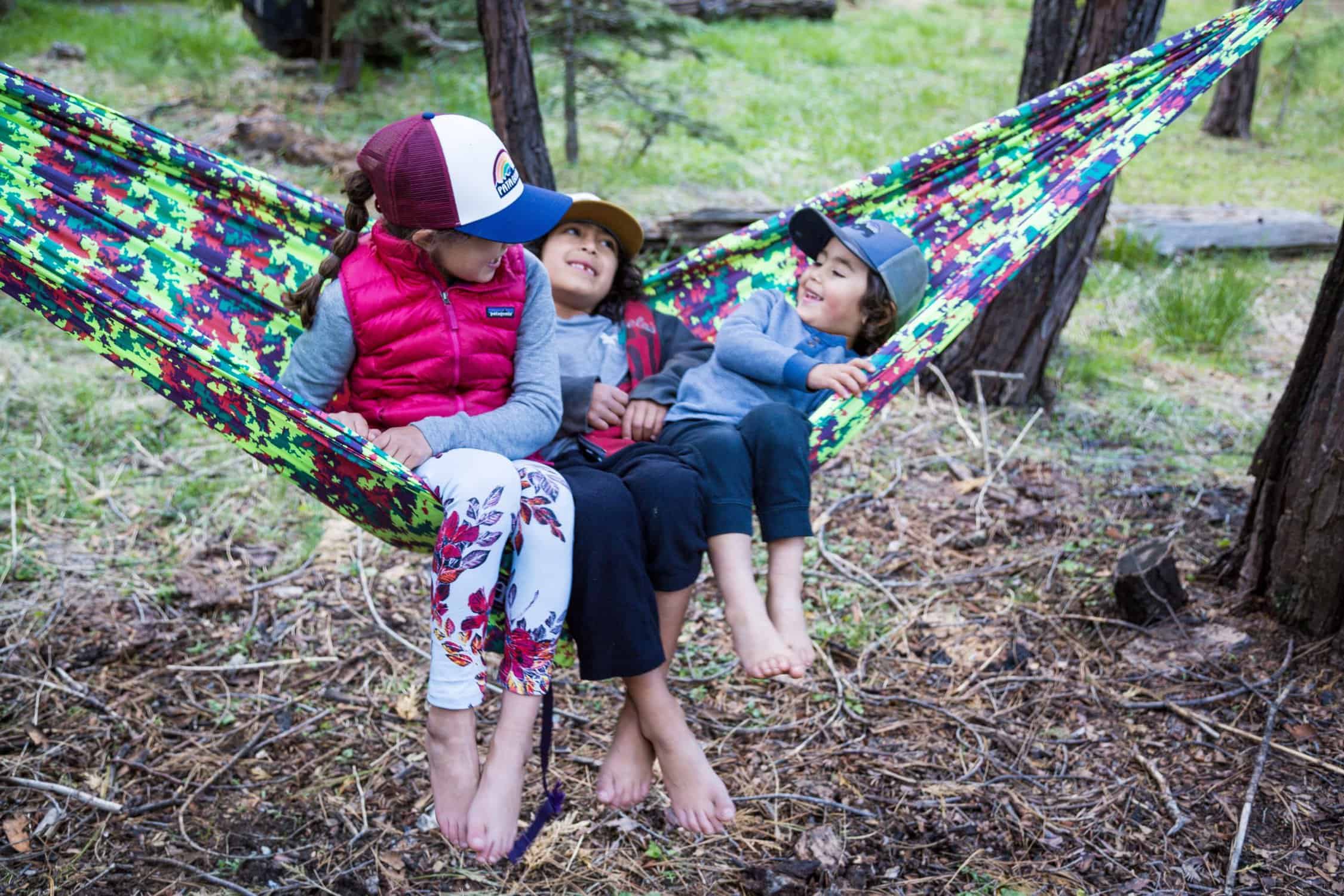 Photo credit: @roaminggonzalez
Photo credit: @roaminggonzalez
Before you pack, do your research
The first thing to do before you ever start packing is to research your campground/campsite and make yourself familiar with what’s there and what’s available. Campgrounds can vary widely in the amenities that they offer. Basic amenities at most established campgrounds include bathrooms, showers, picnic tables, water spigots, trash/recycling, and firepits. Beyond that, you may also find campgrounds with playgrounds, splash parks, stores, restaurants, bike/boat rentals, hammock hook-ups, ice makers, electricity, hot tubs, movie nights, zip lines, laundry, wifi, swimming pools, nature crafts, yoga classes, and so much more!
Check to see if your local campground has information online about the layout of your specific campsite so that you can see how much space you’ll have and what is already there. For example, some campgrounds have water access, a fire pit, a picnic table, and electricity! Some sites have none of the above, so you’d be “roughing it” and will need to bring more in order to be best prepared. Either way, you’ll still need to bring various items for a successful trip.
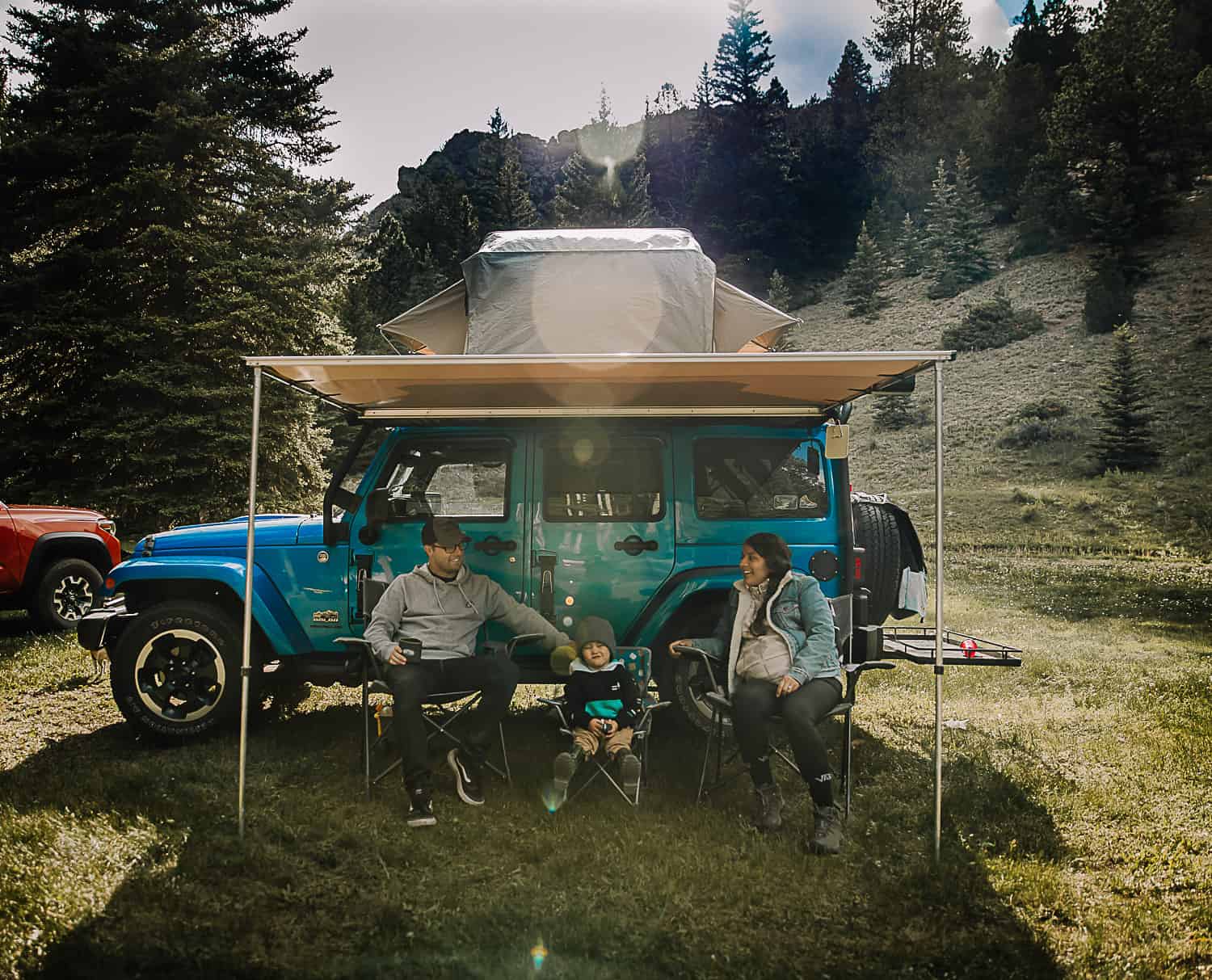 Photo credit: @wildstokefam
Photo credit: @wildstokefam
How to acquire your camping gear affordably
Camping gear can be expensive, so it’s worth trying to find your items below retail price. Gently used equipment can be just as good as brand new at a fraction of the cost. Whatever works for your family’s budget and needs is the best option. Here are some ways to save money while still acquiring everything you need:
- Check your local “buy nothing” or yardsale sites on Facebook.
- Look for camping gear rental services near you; by renting, you can test a product to see if you like it before taking the plunge on a purchase.
- Buy in the off-season or during big sales; prices are sometimes better.
- Borrow from friends.
- Ask for camping gear as gifts from family or friends for holidays or birthdays.
- Check thrift stores; this is where we found our cooler & camp chairs.
- You local “dollar store” should have inexpensive utensils, tablecloths, flashlights, and snacks.
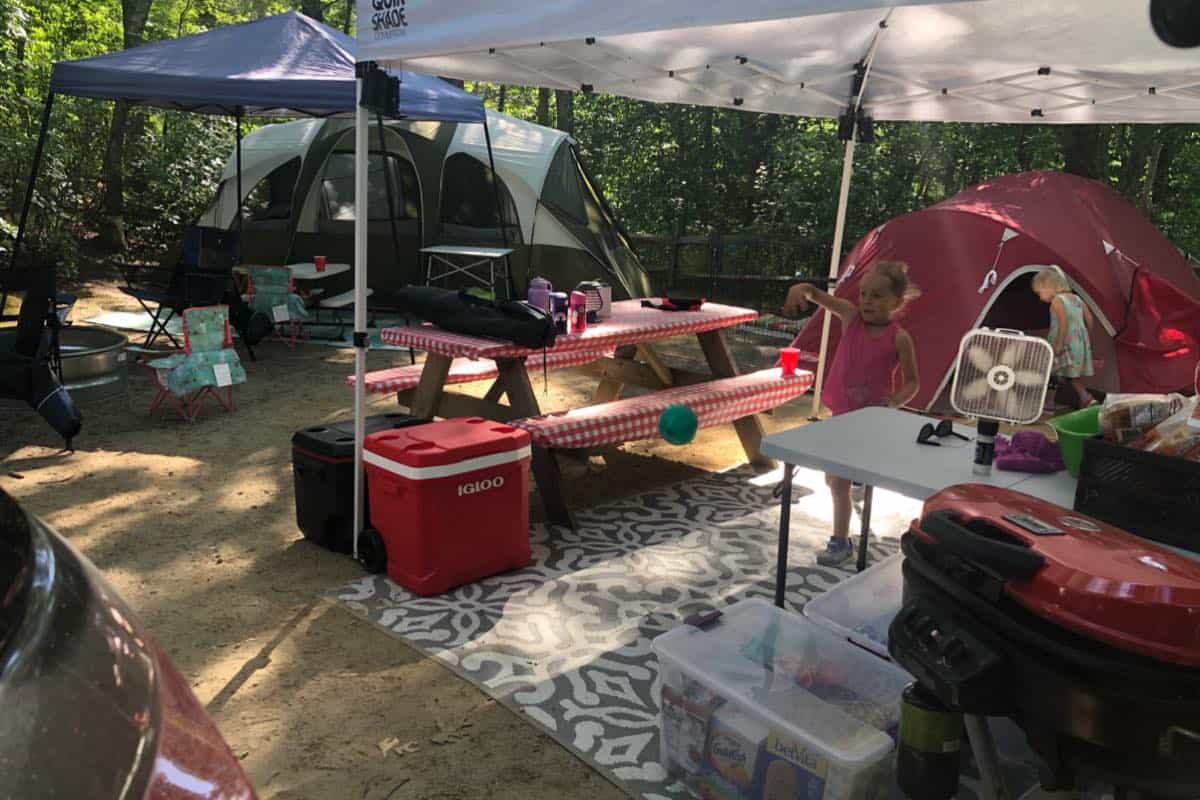
Camp packing tip: make your own list
Every family’s packing list will be different based on when and where you’re camping, the ages of your kids, the weather, the amenities, your comfort level, your camping experience/skill, and tons of other factors. We’ve done our best to provide you with a family packing camping list that you can use as a starter to make your own. We’ve included all the basics, but we’ve also added a ton of optional items you may (or may not) want to bring. You don’t need to bring everything! Camping is all about the simple life, so just bring what you need to feel comfortable.
We highly recommend you start with our list as inspiration, but make your own master copy of your packing list and update it every time you go camping. It’ll change quite a bit over the years as you think of things that would make camping better, as your kids grow, as the seasons change, and as you get more comfortable camping. Making your own list will trigger your brain to remember things that may be important to your family. When packing, make sure to check each item off your list as you pack and then double-check (just in case you got distracted when packing).
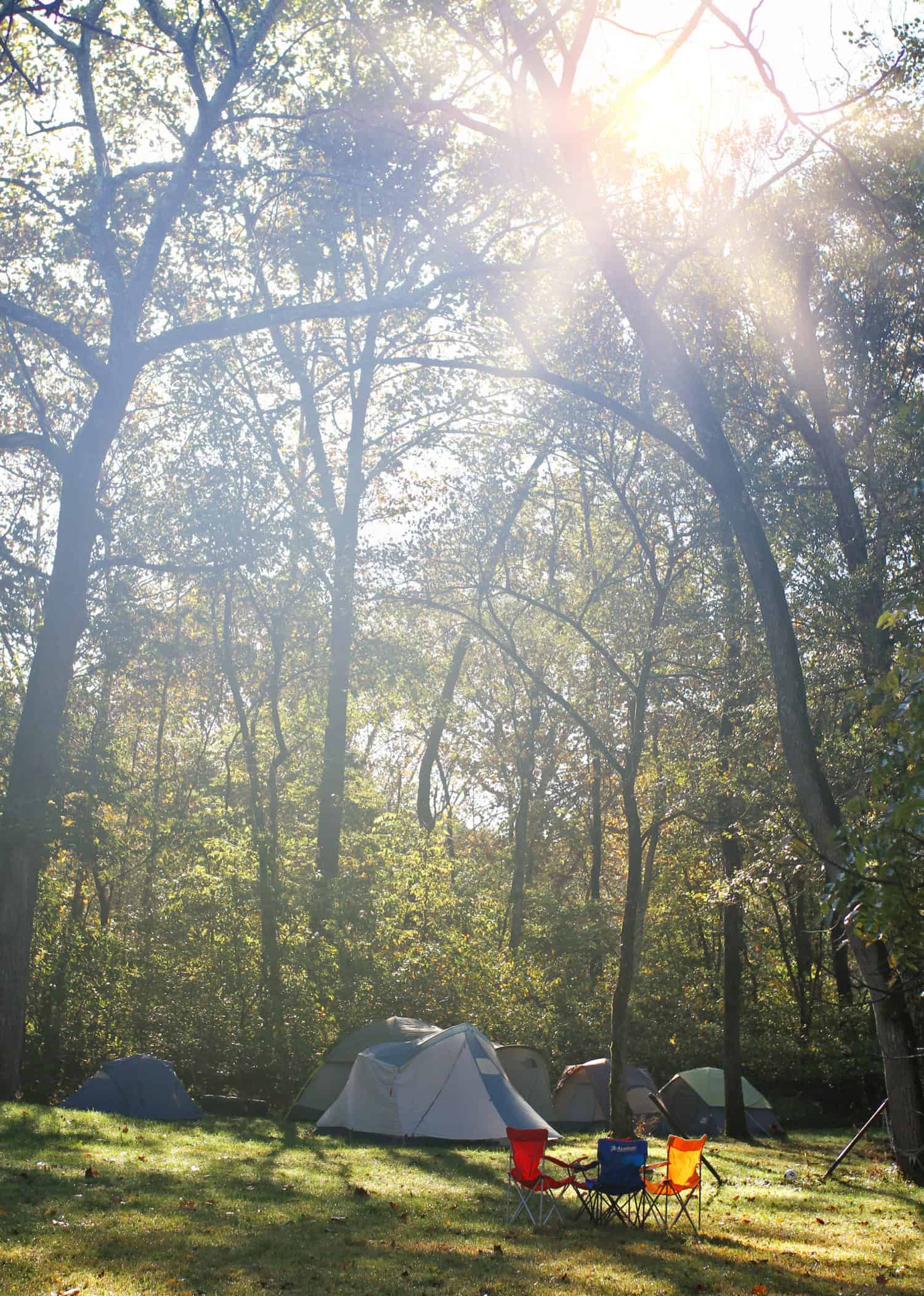
Camping gear for babies and toddlers
Any age child is old enough to go camping. However, as parents, we know that babies and toddlers tend to be more high-needs than elementary-aged kids and above, and that goes for the camping gear we need to bring too! Whether this is your baby’s first camping trip, or 10th, there are some specific items that you may want to bring for your babies and/or toddlers while camping. Here are a few of our top recommendations:
- Pack and play – This can be a safe spot for your child to play in outside at the campground and can also serve as a bed inside your tent.
- Outdoor gate – An adjustable play gate can allow your child to play safely on the ground while still being enclosed within a safe area.
- High chair – If your baby or toddler is used to eating in the same high chair daily, you may consider bringing it. This will make mealtime easier for everyone!
- Kid carrier – A hiking backpack or carrying sling can be helpful, especially when you go on adventures.
- Sound machine – If your campsite has electricity, a sound machine can be helpful to drown out the extra noise during nap time or at night.
- Stroller – Besides being a great way to transport your little one, a stroller can also help carry gear.
- Comfort items – If your child is used to sleeping with a special baby, stuffy, toy, or blanket, be sure to bring it!
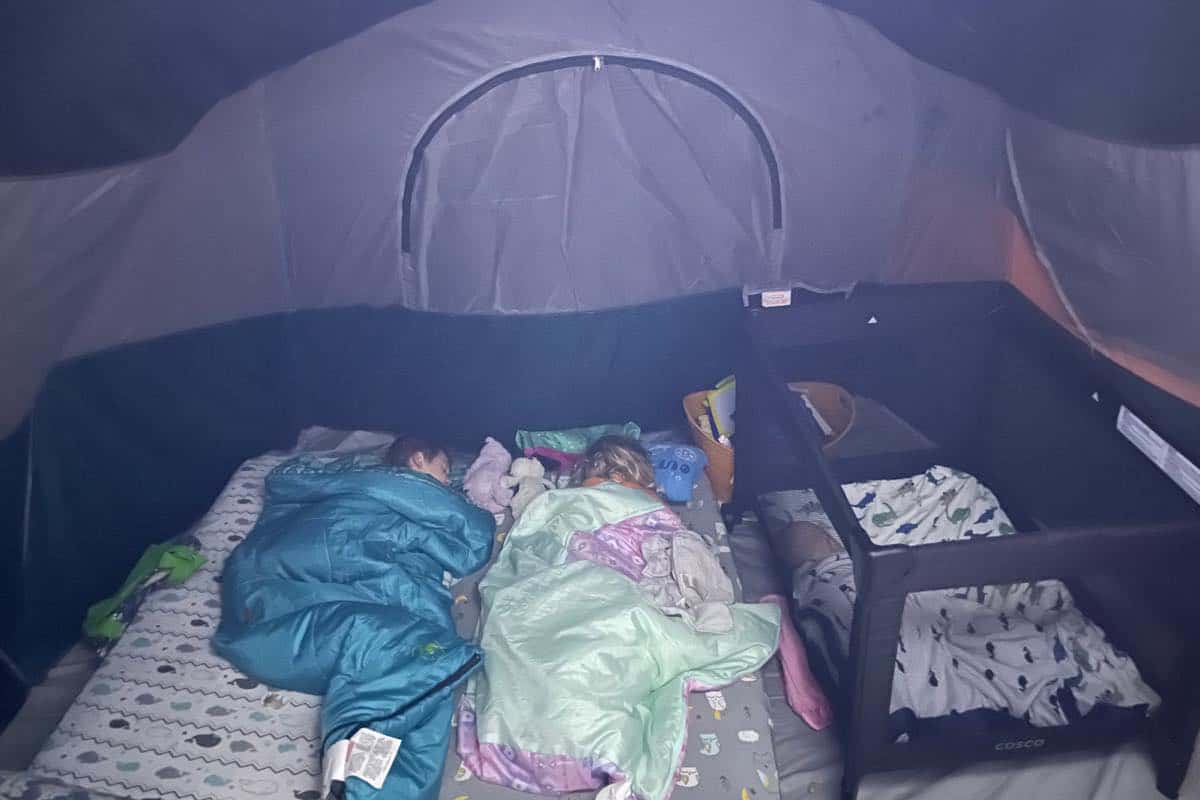
What to bring when camping with dogs
Dogs love to camp! If you can take them, camping can be a great experience for your family and your pup! Here are some things to remember if you’re bringing your canine friend along for the adventure:
- Dog bed – If your dog is used to sleeping on a bed every night, don’t leave it at home! You want them to feel comfortable while camping and have a place to rest during the day.
- Leash and dog lead – Even if your dog is the “goodest-boy ever” you still want to have a leash and even a dog run for your campsite. This is for your dog’s safety as much as anyone else’s.
- Dog food – You’d think this would be a given, but sometimes, I forget it if it isn’t on a list!
- Dog bowl – Always keep a bowl of fresh water out for your pup, especially in hot weather.
- Outdoor dog pen – Sort of like a playpen for dogs, this small but helpful pen will keep your dog contained.
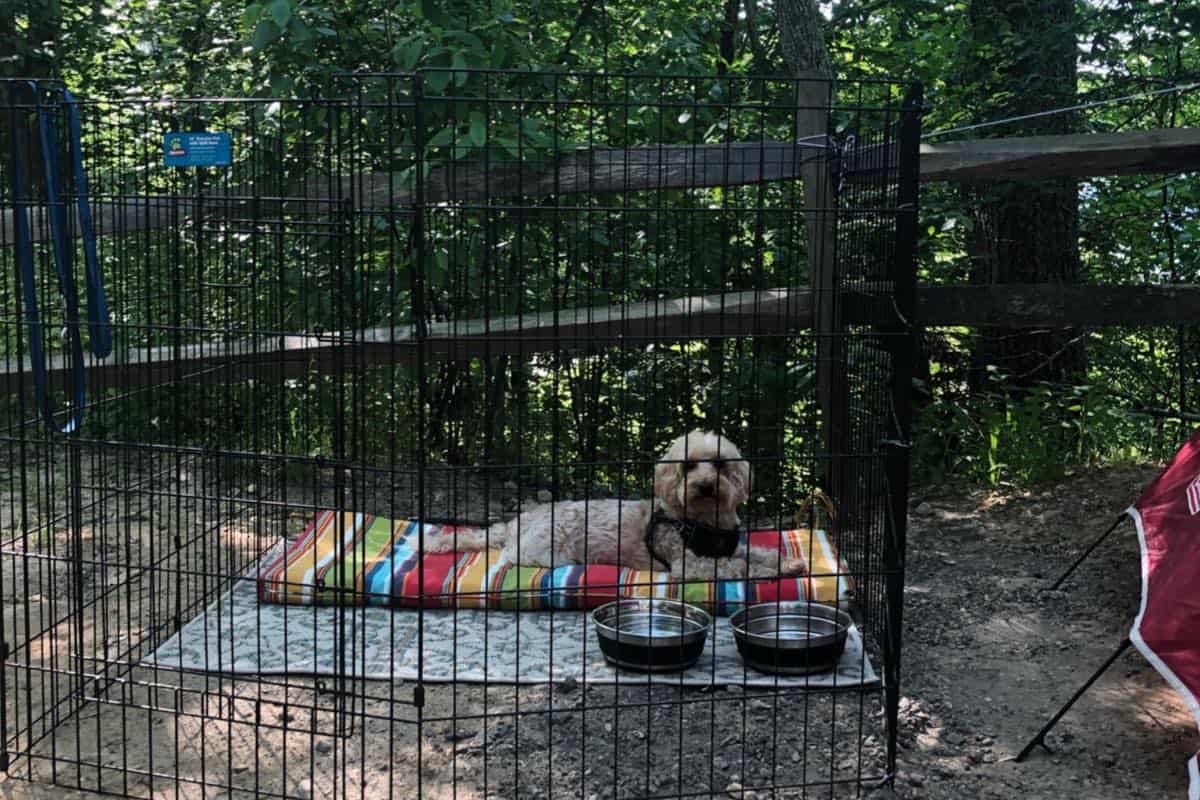
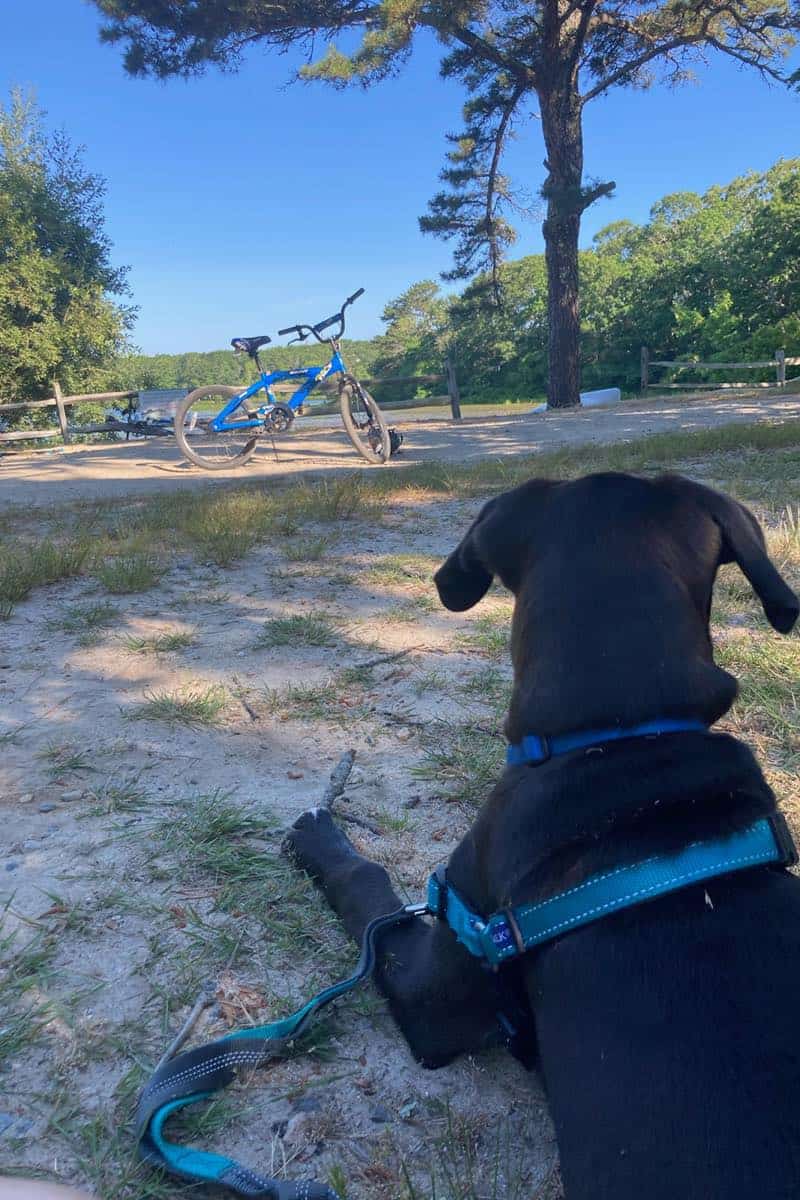
Camping gear you actually need
There’s a lot of gear you can take with you when you go camping. However, you don’t always need all that stuff. If this is your first time camping with kids, you’ll probably significantly overpack, and we’re here to tell you that’s ok! We know that sometimes having everything you just “might” need with you means that you’ll feel more confident going. And if that’s the case and gets you out the door, by all means, pack away!
However, with a little experience, you’ll quickly realize that you don’t need nearly as much stuff for an overnight camping trip as you might think. And actually, the less
stuff you have, the easier it is to get out of the house, and the more creative and resourceful you (and your kids) will learn to be. But again, that takes time (something to look forward to, right?).
For now, we’ll go over the basics of what you need and give you plenty of suggestions for optional items you can also bring to make camping more comfortable and help you feel more prepared.
 Photo credit: @kristcx
Photo credit: @kristcx
Basic camping gear list
Let’s start with the basics of traditional tent camping. Here’s what you will need most of these items for even a bare-bones camping trip.
Tent
You’ll want to be sure you have a tent that is the appropriate size for your family. Tents run on the small side – the number of people that your tent says it’ll hold is only that, leaving you no extra room for gear, luggage, mattresses, spreading out, etc. We recommend upsizing when possible. For example, we have an 8-10 person-sized tent for our family of 4. Having room to move around inside the tent and our sleeping space is key. Also, make sure your tent has a rainfly for protection from the elements. You can leave it off for extra fresh air when it’s not raining.
Here’s a great post on the best way to choose the right tent for your family and our top family tent recommendations.
Tarp or footprint
This item is to lay underneath your tent as a moisture barrier and protect against abrasions and punctures. Not all tents come with a footprint included, so this is something that you may need to find or purchase separately. Make sure the footprint is a bit smaller (up to 2 inches smaller) than the outline of your tent. This may sound counterintuitive, but if the tarp/footprint extends out from under the tent edge or is the same size, it can cause water to pool between the footprint and your tent floor in the rain.
Sleeping bags
Sleeping under the stars is always a great idea, unless you can’t get comfortable and stay warm. One key element to this issue is a well-fitting, cozy sleeping bag. For kids, a bag like the Kids Kelty Mistral that keeps kids toasty in temperatures below 40-degrees, is a great investment. For the smaller ones, a sleeping sack/bag made for babies, like this one from Morrison Outdoors, might be just the right fit. If you’re camping in the summer, it may be enough to just bring extra blankets and sheets and sleep on top of your sleeping bag.
Sleeping pad or cot
Every good camping sleep system also includes a sleeping mat or a cot. Mats are a great option because you can buy them a little big to last a longer. A self-inflating sleeping pad like the REI Kindercamp is nice and worth the extra cost because the kids can help set up their own sleeping spot and you don’t need to bring an additional air pump. If you want something bigger (for multiple kids or kids plus an adult, we love the REI Co-op Camp Dreamer Double Self-Inflating Deluxe Bed. If you’re looking for something that gets your little one off the ground, or if you have multiple kids and are tight on space, check out the Kid-O-Bunk bunk bed cots.
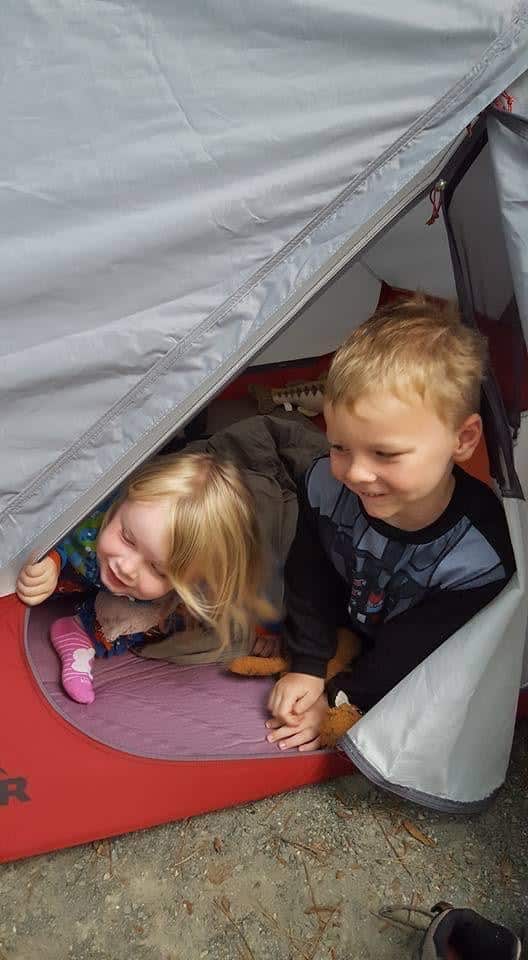 Photo credit: @coleyraeh
Photo credit: @coleyraeh
Illumination – headlamps, flashlights, lanterns
You’ll want to be able to see in the dark when camping. Headlamps offer a perfect hands-free illumination option. Once placed on the head your kid can freely move about without worrying about dropping something or shining it in the right place. We love these high-quality adjustable Petzl Tikka headlamps. Flashlights are a classic option and come in so many fun colors and sizes. Small flashlights like these EverBrite Flashlights come in multiple packs for the whole family. If you’re looking for something a bit more substantial, these LED tactical flashlights are bright, rechargeable, magnetic, and waterproof. Lanterns come in all shapes and are made from a variety of materials. One style to consider is an ultra-lightweight inflatable lantern like these LuminAid lanterns, that can also charge your phone!
Rain shelter
A rain shelter is a great way to provide sun and rain protection over any area of your campsite. Sometimes these are called easy-up tents or pop-up shelters. We put one up over our kitchen space, so I have shade and rain protection to prepare meals. A rain shelter isn’t 100% necessary every time we go camping, but it’s a blessing if we’re expecting any rain or need some additional shade for little ones. It’s also an excellent purchase for picnics, ballgames, tailgating, and other events.
Outdoor/indoor rug
An easy-to-clean outdoor/indoor rug or small carpet is an excellent addition to your campsite. Set it right outside the entryway into your tent to minimize dirt, leaves, debris, mud, and sand tracked into your tent. It can quickly be swept or hosed off to clean. The last thing you want to feel when you slip into your sleeping bag is dirt or sand.
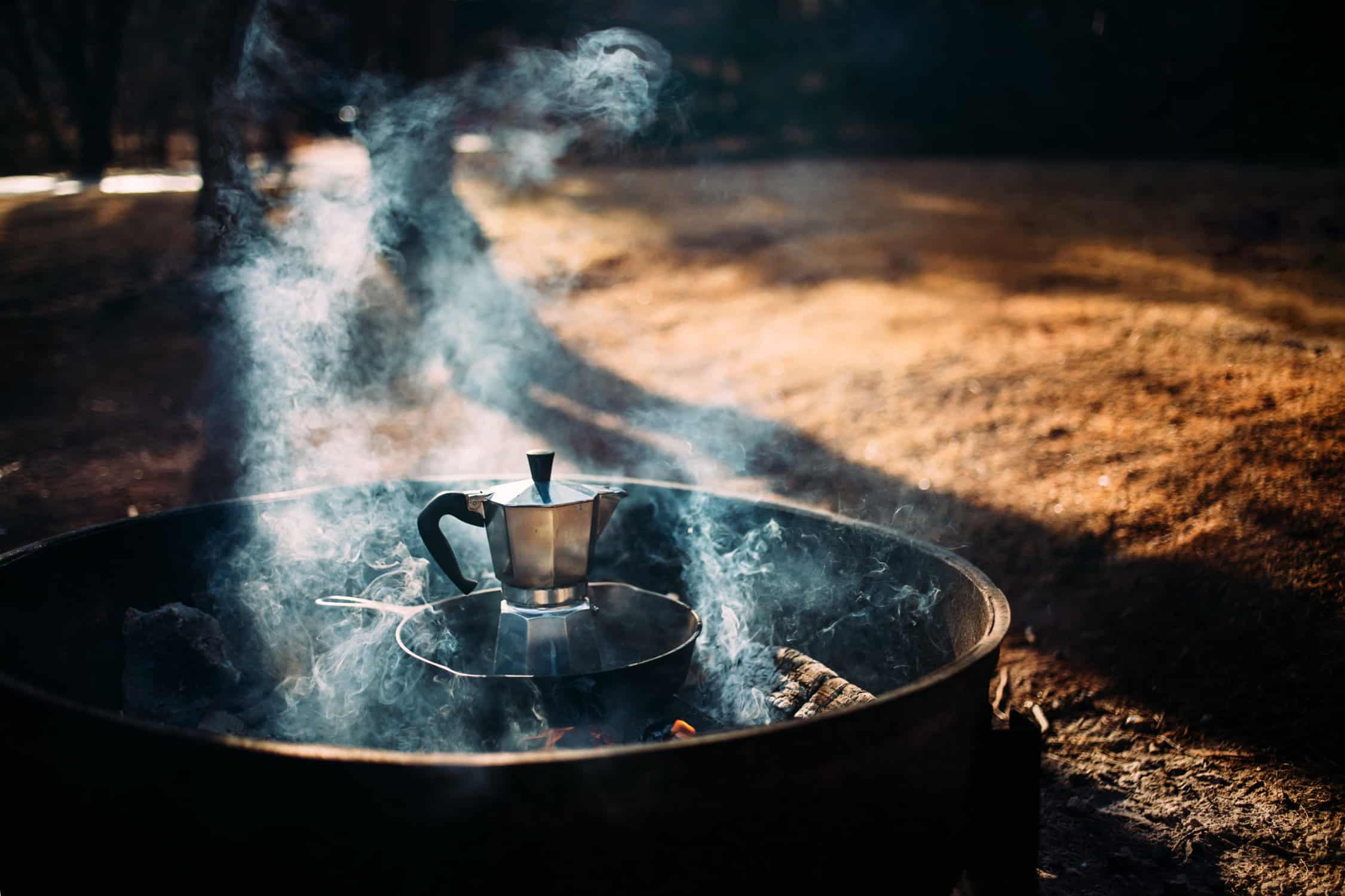 Photo credit: @kristcx
Photo credit: @kristcx
Trash receptacle
A trash can/barrel is a must-have for any campsite. Sometimes campgrounds will provide these for you, but not always. We have one where the lid clicks closed so no raccoons, squirrel, or skunks can get it. However, if you have bears in your area, you might want to avoid keeping any trash on your site if possible. Be sure to check your campground’s local rules and regulations regarding trash storage and disposal.
Camp table
Some campsites have picnic tables available at every site to provide a space for eating, cooking, playing games, etc. If yours does, that’s great! However, if it doesn’t, you’ll want to consider bringing one. I suggest a collapsable lightweight table crafted for outdoor use.
Camp chairs
Collapsible, comfortable, lightweight, waterproof chairs are the best for camping. Some models have cup holders, headrests, or overhead shades. Pick one that suits your needs! We also recommend small camping chairs for little kids. A chair that’s just the right size like this Coleman Kids Chair is a great option. (Although that’s not to say they still won’t steal your chair!) It’ll give them a safe (and just the right size) place to sit around the fire and feel like part of the group.
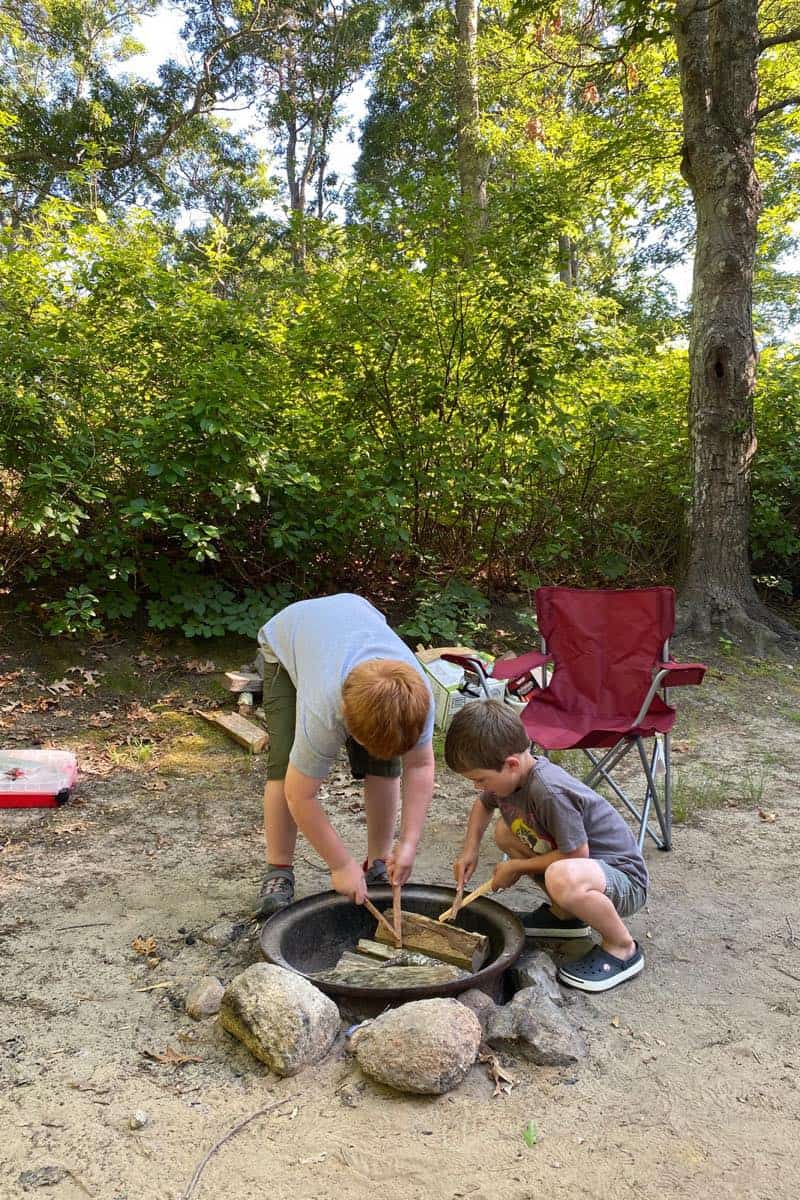
Camp kitchen gear & essentials
Your camp kitchen gear essentials will depend a lot on the type of food that you’ll bring with you and how you want to cook it. If you do all your meal prep ahead of time or like cooking directly on an open fire, you may need less gear than if you were planning to prep, assemble, and cook your meals onsite. Before you start making your kitchen gear list, consider the food, snacks and meals that you’ll be eating (and how many of them), and then come up with a list of kitchen items that you’ll need (step-by-step ) when making and cooking the food.
When planning your meals, you’ll want to be sure to pick your “hot” meals around the type of heat source you’ll have available at your campsite. You’ll probably have easy access to a campfire. Cooking over a campfire isn’t hard, but you may need a few basic items to be most efficient, such as an over-fire grill grate. Another option is a portable camp stove. Some campsites may have charcoal grills for you to use, and in that case, you’ll need to bring your own charcoal.
Stove or grill
If you’d like to eat a hot meal while camping, you’ll need something to help you cook your food. As mentioned above, some campsites have fire pits perfect for over-the-fire cooking. If you’re cooking directly on a flame, consider a grill grate or some roasting sticks or pie irons. However, you might also want to bring a small grill or cooktop. This will allow you to cook nearly anything without needing a steady fire going (and can be used in the rain).
Wash bins, dish soap & sponge
Plastic or metal wash bins for holding and cleaning dirty dishes are a must-have. Finding nesting bins is a space saver; one can be used to wash, while the other can be used to rinse. Make sure your soap won’t harm the local wildlife – many campgrounds require use of biodegradable soap. Also, check with your local campsite regarding how to properly dispose of all food scraps, and any special areas to dispose of grey water (used dish washing water).
Tablecloth
While not essential, a plastic tablecloth with fabric backing is great for use on a picnic table. This allows for super easy cleanup and splinter prevention!
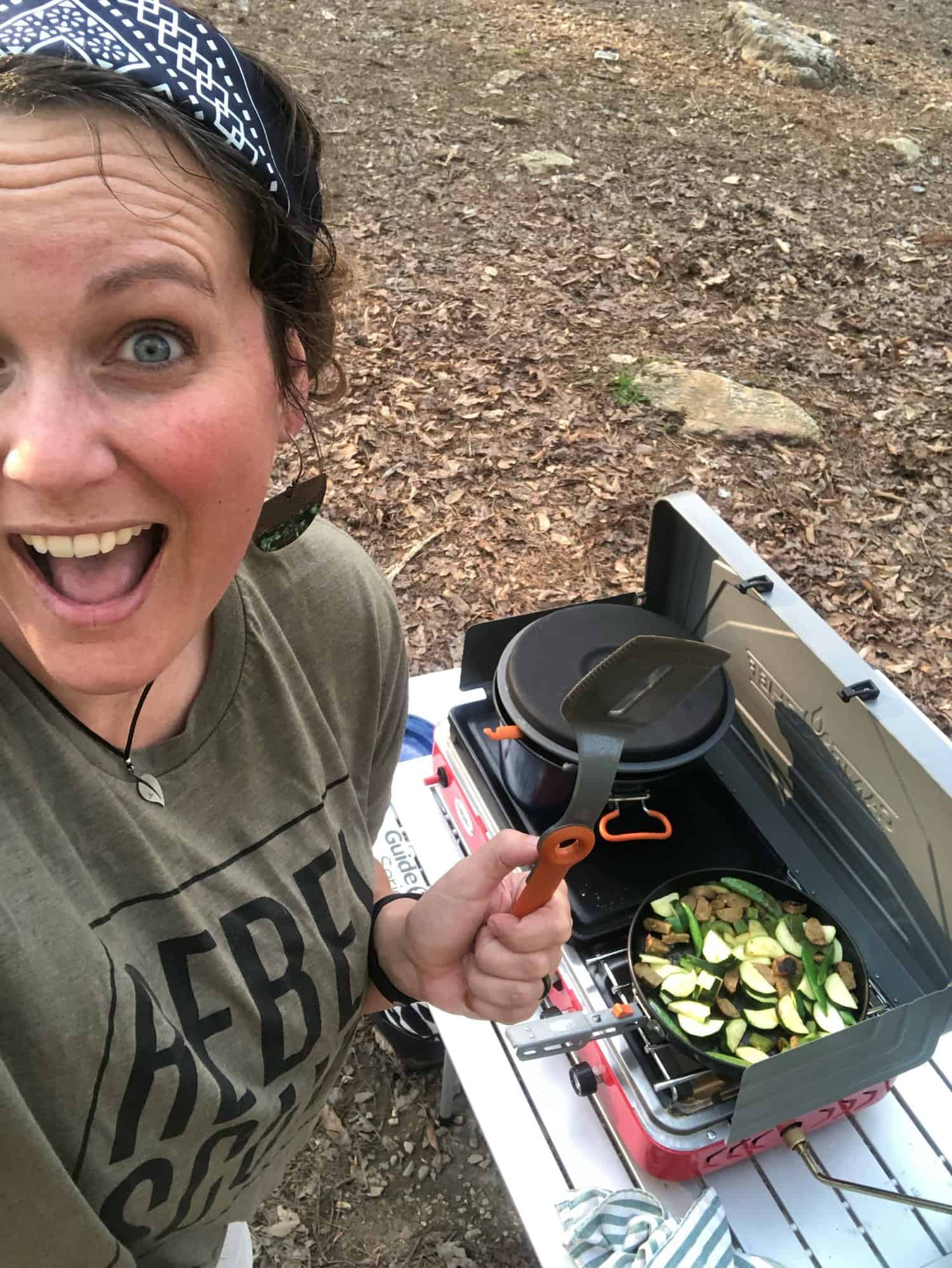 Photo credit: @coleyraeh
Photo credit: @coleyraeh
Pots and pans
If you’ll be camping at an established campsite near your vehicle (as opposed to hiking in to a backcountry campsite with only the stuff you can carry), you’re not limited on space for the kitchen cookware you bring. Full-sized pots, pans, knives, utensils, and the cast iron skill from your home kitchen will work great! No need to buy specialty camping cookware. Depending on what you’re cooking and how (size of cooking surface), bring the appropriate size.
Pot holders, dish towels, wash rags, and cloth napkins
Choose something you don’t mind getting dirty. Second-hand shops are the place to look for these items that you can put into your camping kitchen storage and use exclusively for this purpose.
Plates, cups, utensils
Sturdy plastic is a good choice for these items. You can use paper or plastic for convenience, but if you can choose something more sustainable and reusable, the better. Again, you can find inexpensive ones at the dollar store.
Cutting board & sharp knife
If you’ll need to chop veggies, cut meat or slice anything for your meals, bring a sturdy cutting board and a sharp knife. Remember to keep the knife in a sealable container or with a sheath on it when not in use for safety.
Cooler(s)
The number and type of coolers you bring camping will depend on how much (and what) you bring for food. A basic cooler with ice packs is essential for keeping perishable food and drinks cold. We usually use the reusable ice blocks from Yeti in a Yeti cooler for our food. That keeps the ice from melting and having your food swimming around in melted ice water. We do use regular ice for keeping drinks cold. And if we need ice for drinks, we’ll bring a separate special cooler for that.
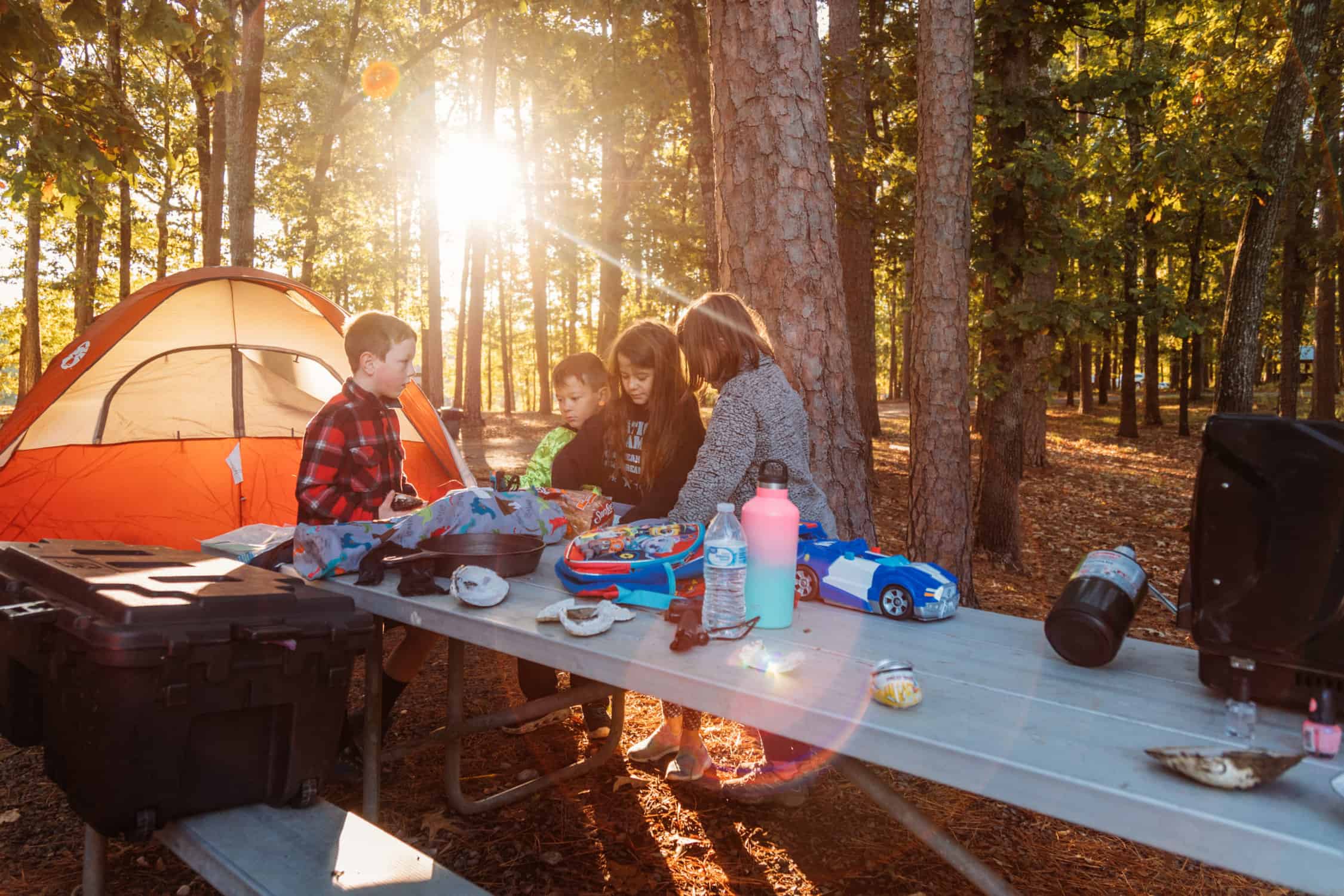 Photo credit: @kristcx
Photo credit: @kristcx
Water dispenser
Instead of using single-use plastic water bottles, we opted for a 5-gallon water dispenser on our camp table. This is not only for easy water storage, but the kids can refill their water bottles independently as needed. We can also use this water for cooking, brushing teeth, washing hands, etc. as needed. Depending on the length of your tip and access to water, you can bring your own water from home or fill it at the campsite.
Paper towels/napkins
A roll of disposable paper towels is always a good idea for quick and easy clean-up. However, if you want to cut down on your waste, consider bringing tea towels or clothing napkins. The soiled towels get thrown into the laundry bag after use and reused for each trip.
Tin foil
Tin foil has a number of uses and is so helpful and handy to have when cooking at the campsite. Foil can be used for both cooking or food storage. We like to make tin foil meal packets to cook on the grill or directly in the camp fire for easy dish-free clean up.
Cooking utensils
Think about the food you’ll be cooking and consider what utensils you’ll need for cooking. A mixing spoon, spatula, tongs, and measuring cups are all basic needs for a camping trip. You may also need some specialty utensils like a can opener, wine key, whisk, or strainer for cooking some items.
Refillable water bottles
These can be used in conjunction with your water dispenser to cut down on the amount of waste and plastic you’re using on your camping trip. Be sure to stay hydrated when camping, and bring your water with you on every adventure.
Coffee pot/french press
It’s a proven fact that coffee tastes better when camping! And after a possibly long night, you may need some extra java in the morning. If you’re camping at a site that has an electrical plug in there’s no rule that says you can’t bring your coffee pot from home! This way, you’re sure to have coffee made just the way you like it, and plenty of it. Be sure to bring an extension cord to stretch where you need it to in your campsite. Don’t forget your coffee grounds and filters (or k-cups, or whatever you use). If you don’t have electricity, consider a french press coffee maker or a pour-over method.
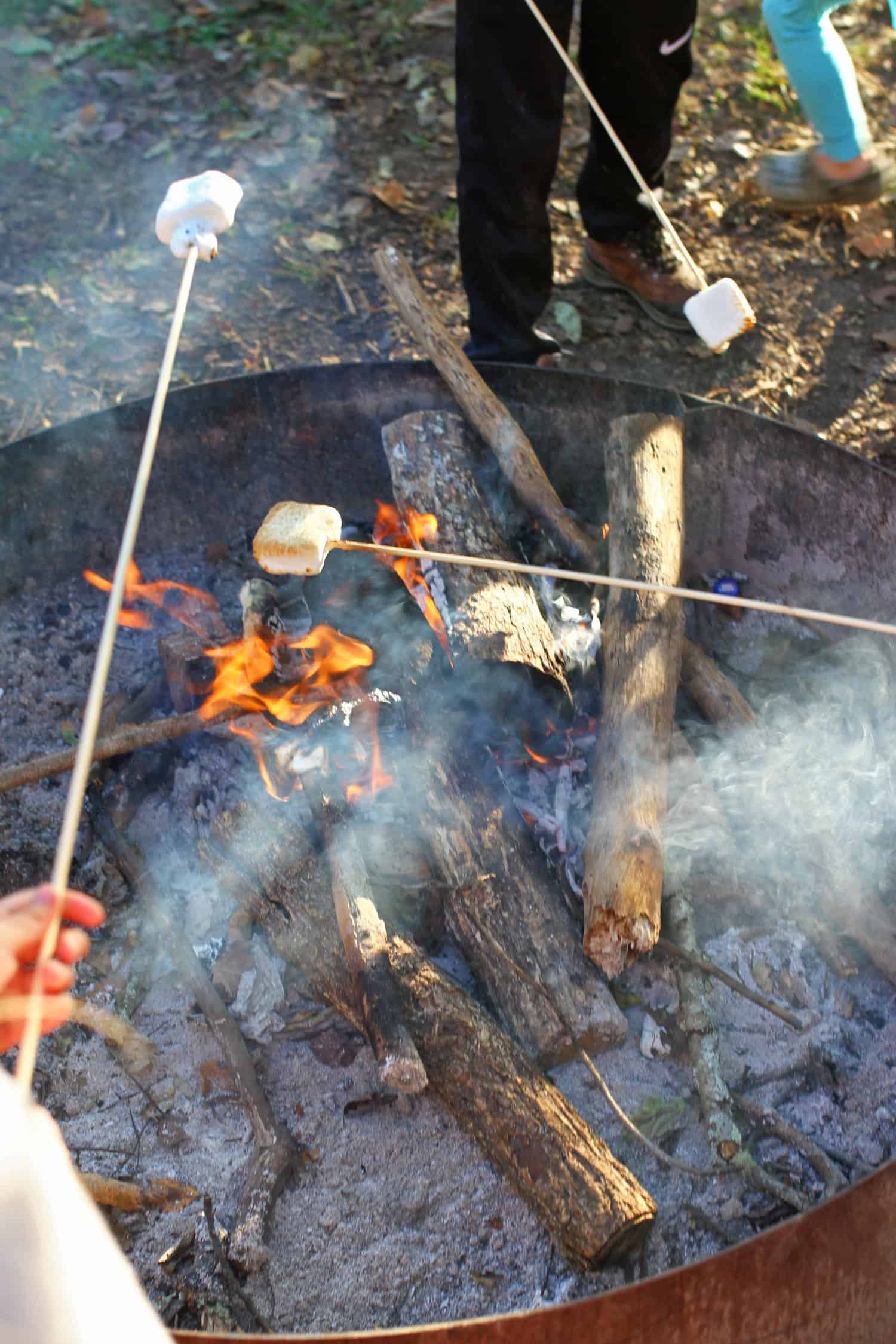
Camping food items to pack
Of course, you can bring whatever food you’d like, but here are some typical camping foods that are easy to bring, store, make and eat to add to your camping gear list! There’s no need for fancy meals when you’re camping. Just be sure to bring enough food! And be prepared for it to taste great, because everything tastes better when you’re camping!
- Eggs
- Bacon or sausage
- Bread
- English muffins
- Deli meat
- Peanut butter
- Jelly
- Hot dogs
- Hamburgers
- Chicken breasts
- Fish fillets
- Rice
- Potatoes
- Veggies
- Fruit
- Protein bars
- Pretzels
- Trail mix
- S’mores fixings – chocolate, marshmallows, and graham crackers
- Gatorade or a similar hydrating drink
- Salt & pepper
- Seasonings & spices
- Condiments
- Cooking spray
- Coffee & filters
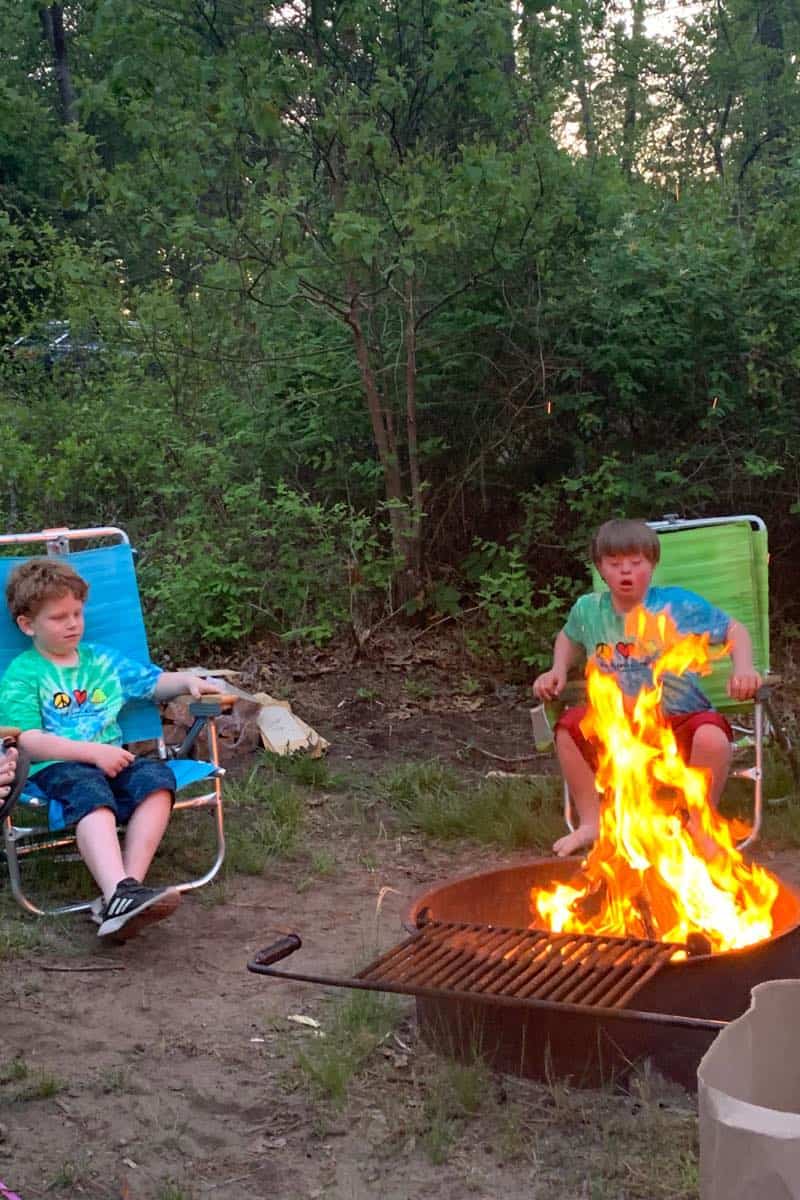
Personal care items
Just because you’re out in the wild doesn’t mean you must stop taking care of yourself. So here’s a list of personal care items to add to your camping gear list. Remember that a standard first aid kit might include some of these items.
- Toothbrush & toothpaste
- Floss
- Shampoo & conditioner
- Soap
- Medications
- Vitamins
- OTC pain relievers
- Bug spray
- Sunscreen
- Lotion
- Aloe vera gel
- Burn relief cream
- Thermometer
- Moleskin for blisters
- Band-aids/bandages
- Antibiotic cream
- Hairbrush
- Deodorant
- Contact lens solution
- Feminine products
- Bath towels & face cloths
- Razor
- Toilet paper (depending on your campsite set-up)
- Diapers, wipes, pull-ups if needed
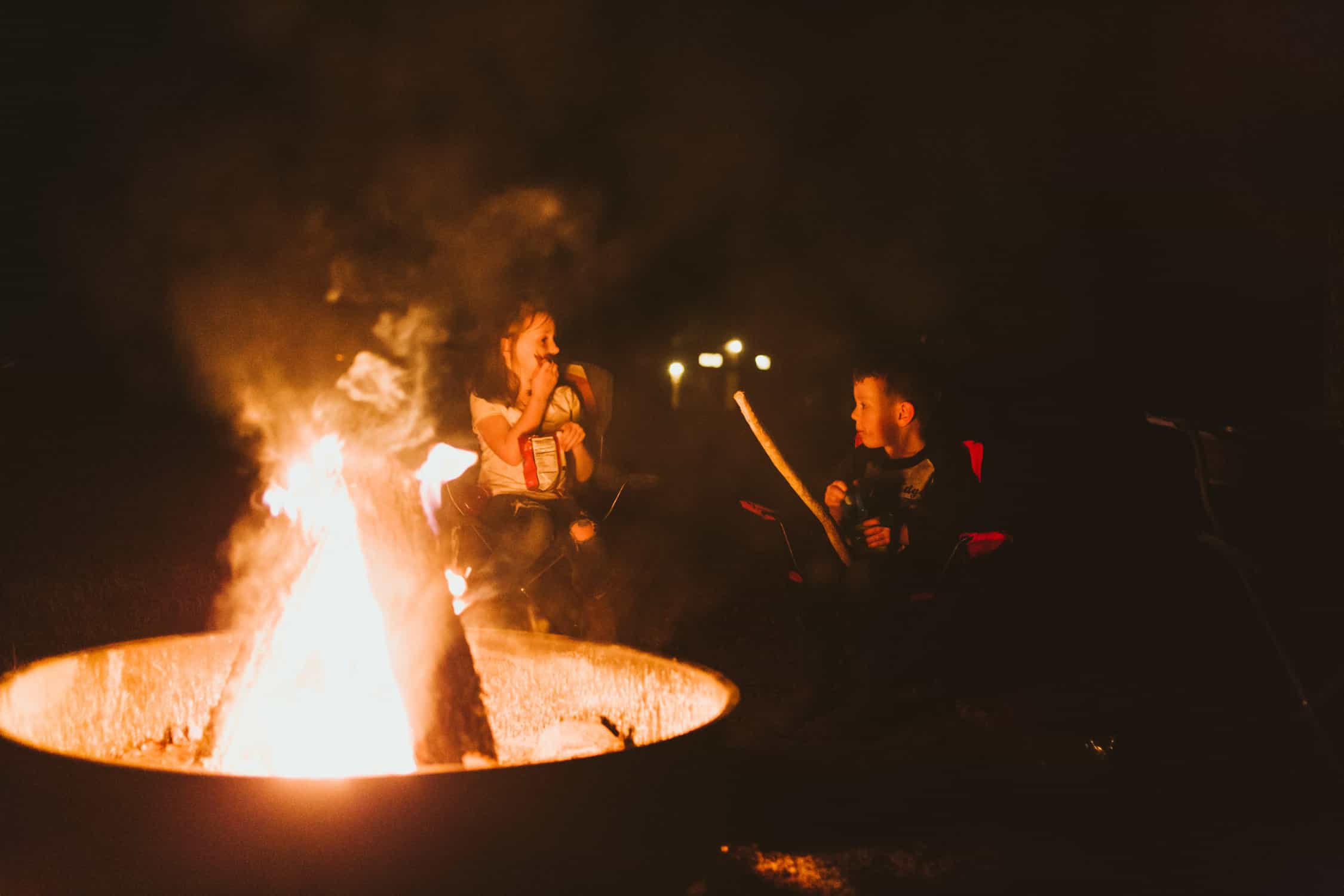 Photo credit: @kristcx
Photo credit: @kristcx
Clothing for your camping gear list
Depending on the season and where you are camping, you will want to bring different clothing items for you and everyone in your family. What you transport your clothes in is up to you! We used a clear tote that we kept in the car. It was easy to transport and didn’t take up much room. Other options include a suitcase, duffel bags, backpacks, re-purposed laundry bags, or a laundry basket. For adults and teenagers, one change of clothes or a shirt and pants/shorts for each day should suffice. However, kids tend to get dirty quickly when camping (especially if there’s water around), so consider bringing two outfits for each day for the younger kids and babies. But, also know that a little dirt won’t hurt and wearing dirty clothes when camping isn’t the end of the world!
Here are some clothing items for your camping trip that you may consider packing:
Base layers
Merino wool base layers are fantastic options for almost every season. The wool is lightweight, not scratchy, and warm. Woold pieces can be used alone on warmer days or can add a much-needed layer of comfort on those chilly winter escapades. One of our favorite brands that makes beautiful, soft layers is NUI Organics. We love their collection of soft merino wool, which comes in a variety of beautiful solid gender-neutral colors (so they can be passed down kid to kid). This company, in particular, is great because they carry layers for the entire family (adults included).
Check out our post on the Best Merino Wool Layers for Kids for a comprehensive list of the best wool brands, clothing options, and price points.
Socks & underwear
I might be the wrong person to ask this question because my formula for the number of pairs of underwear to bring on a trip goes like this. # of days you are gone X 3 = # pairs of underwear to bring. Is this too much? ALWAYS! But I’d rather be overprepared in this department. The same goes for socks, and wool is always a good option. Our favorite brands are Smartwool and Bombas.
Rain gear
No matter the weather forecast, I would recommend bringing rain gear with you. A rain jacket for every family member, or even better, rain suits! The REI Co-op Rainwall Jacket and Rainwall Pants are great options for a two-piece set. For the younger kids, full-body rain suits are a great choice because there is little to no worry about their underlayers getting wet when the weather turns. Our longtime favorite rain suit for everyday wet adventures has been the Oaki trail suit, but we also really love the Polarn O. Pyret Rain Shell with interior fleece-lining for colder rainy day adventures.
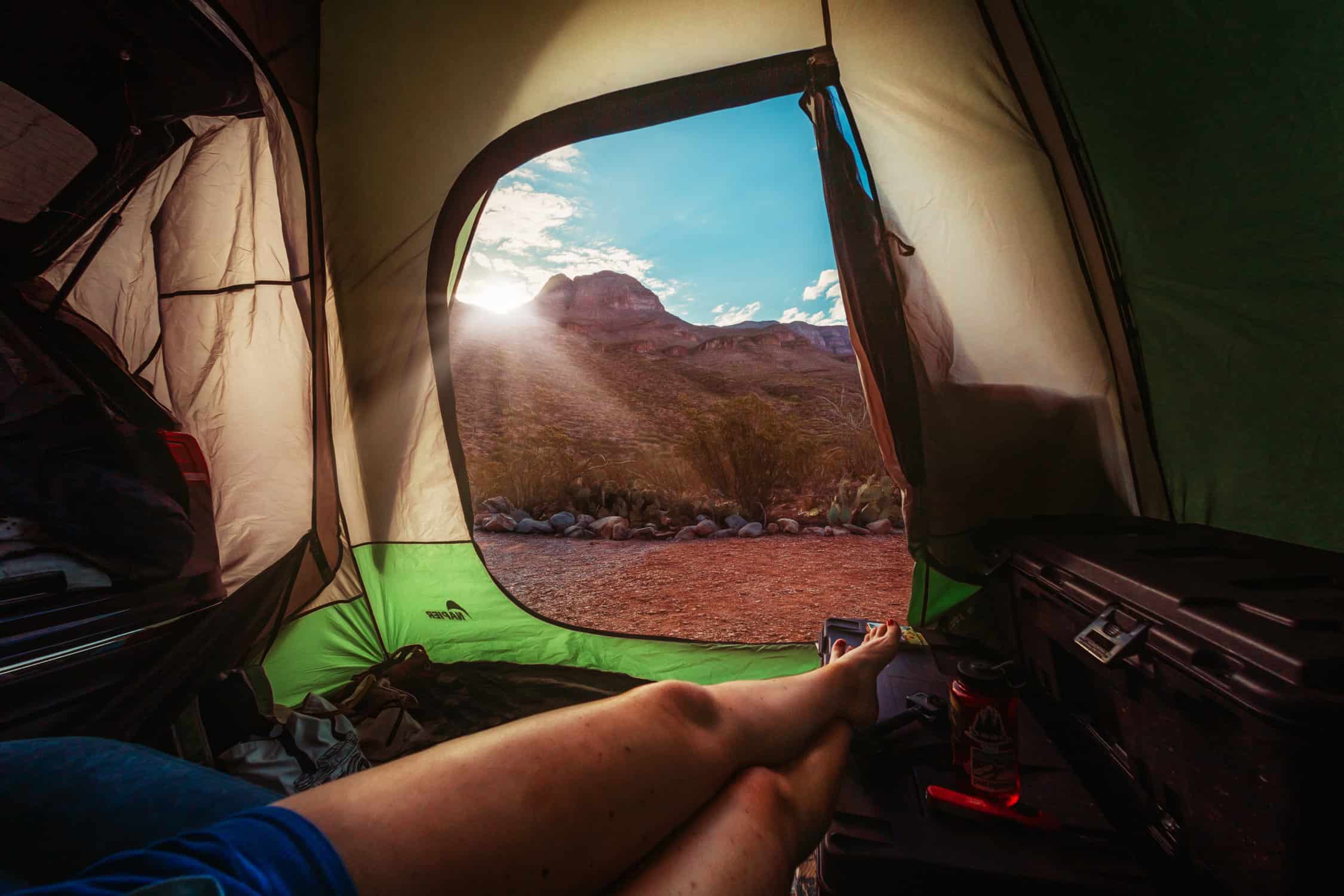 Photo credit: @kristcx
Photo credit: @kristcx
Swim suits
If you’re camping during the spring and summer, don’t forget to bring a swimsuit. If you’re lucky, your campground will include a body of water suitable for swimming. We like rashguards for the kids because it adds an extra layer of protection from the sun and bugs.
Gloves & hats
If it’ll be cold, bring a warm hat for each family member and warm waterproof gloves in the winter. If it’s sunny out, consider bringing a wide-brimmed hat for sun protection during the rest of the year. Check out our full gear review post for a breakdown of the best kids’ gloves and mittens for outdoor play.
Pajamas
Remember that the temperature can vary significantly from day to night, and you are less protected from the elements while sleeping outside. Most of the time, your wool layers can double as pajamas or serve as your base layer (underneath clothes) to keep you and the kids extra toasty warm on cold nights or when camping in cooler temperatures. Light weight layers will help keep kids cool when camping in the hot summer months.
Shoes
Bringing an extra pair of shoes for each family member is a good idea. In the winter, be sure to bring your warm boots. In the summer, a sturdy pair of sandals is a good idea. If you’re planning on doing some hiking, biking or creeking, remember to bring your best shoes for that activity. Also, a pair of shower shoes or flip-flops if you’ll be using a public shower while camping.
Sunglasses
You’ll be spending a lot of time outdoors; let’s protect those eyes! A polarized pair will give you a clearer view too! For little kids, we love these Babiator sunglasses that come in 2 styles (the Navigator UV and the Aviator) and a variety of colors. Frames are made from rubber, making them strong and flexible, shock and impact resistant.
Laundry bag
Don’t forget something to hold all of your dirty clothes. A large laundry bag with a drawstring top works well for us. In a pinch, you can also use a trash bag or designate one empty duffle bag or suitcase to hold all the dirty laundry.
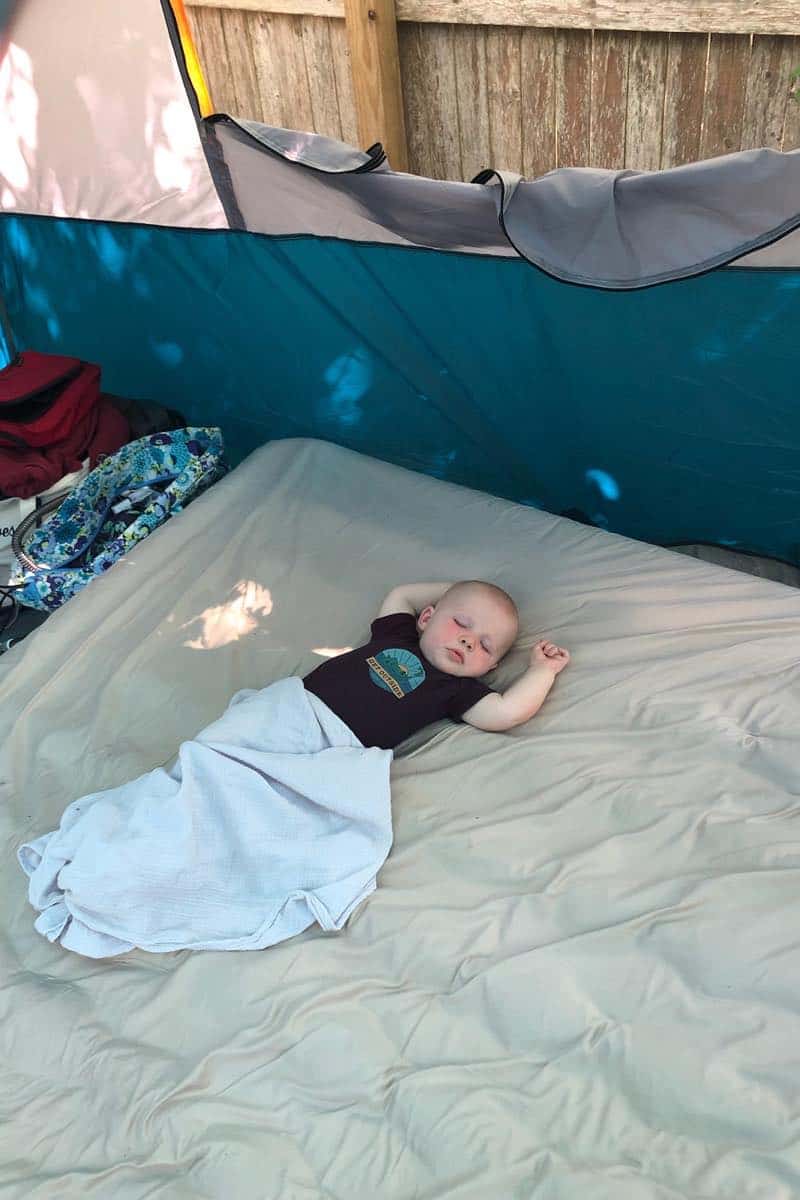
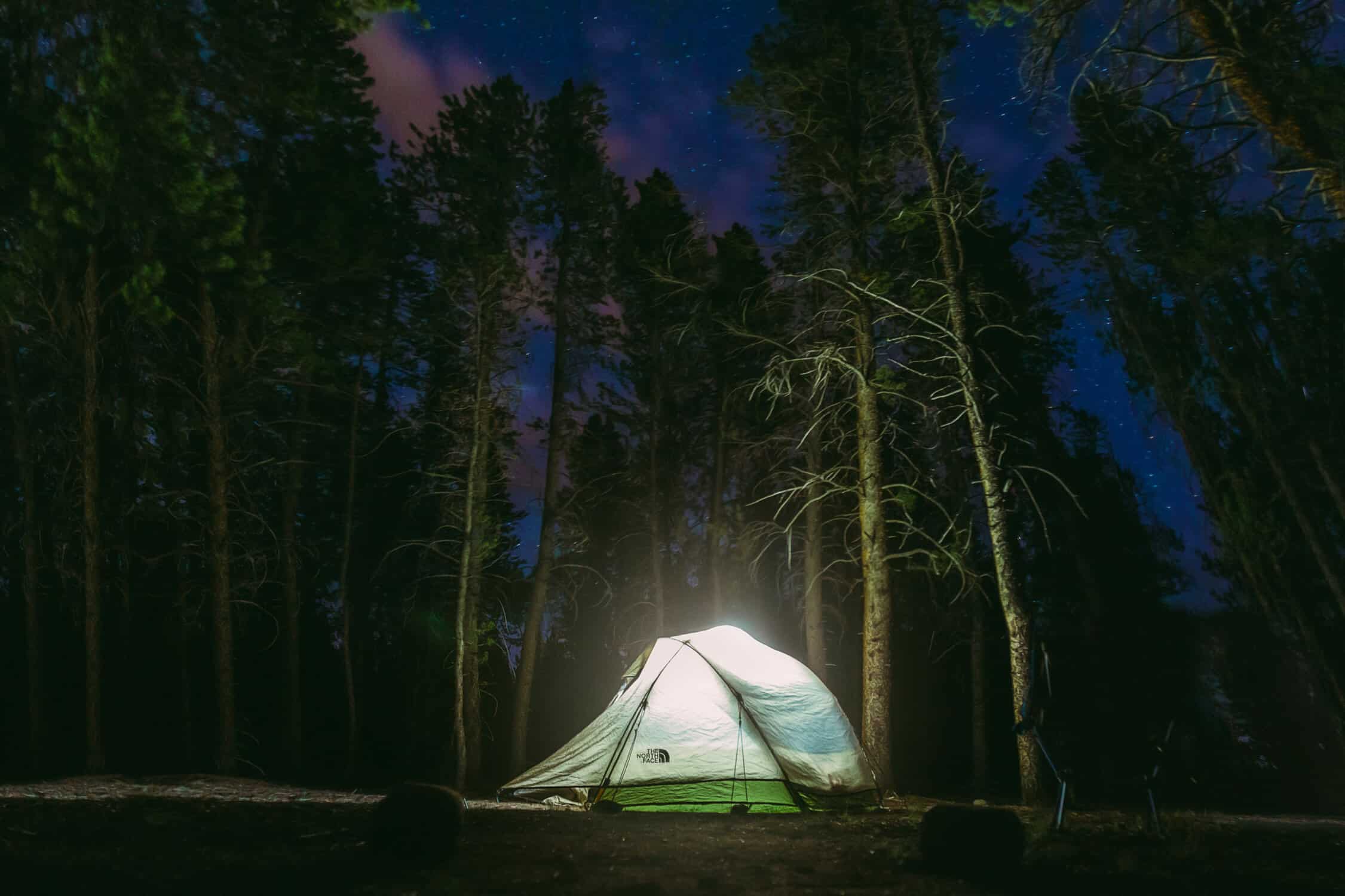
Campsite fun
Camping with your family should be a fun experience, and while being out in nature is a form of entertainment all on its own, sometimes you need a few other ideas of things to do or bring from home to help the play. There are a ton of fun activities you can play around the campfire and inside a camping tent to make your camping experience a memorable one. Here are some suggestions for games and enjoyment you can bring along with you.
Walkie-talkies
Walkie-talkies are perhaps one of the best outdoor toys you can purchase for your kids! Not only are they fun to use and can be a catalyst for hours of imaginative play, but they are also a helpful device for keeping track of our busy independent kids when they’re out exploring or running around the campsite. These Topsung rechargeable walkie-talkies are great because they are long-range and come in packs of two or three.
Binoculars
My binoculars go with me on every outdoor adventure, so this is on my essentials list. But, if you aren’t a birder like I am, you might want to think about bringing a pair of binoculars to get an up-close look at some of the natural wonders you might find. A good pair of high-resolution, waterproof binoculars like these Occer compact binoculars will make sure your kids don’t miss a thing (but they also won’t break the bank).
Field guides
Bringing a field guide relevant to the area you are visiting will be a great way to engage your kids in their environment. We all know about the fantastic apps for identifying plants, birds, and even bugs, but a good old-fashioned guidebook is an unplugged version perfect for your camping trip.
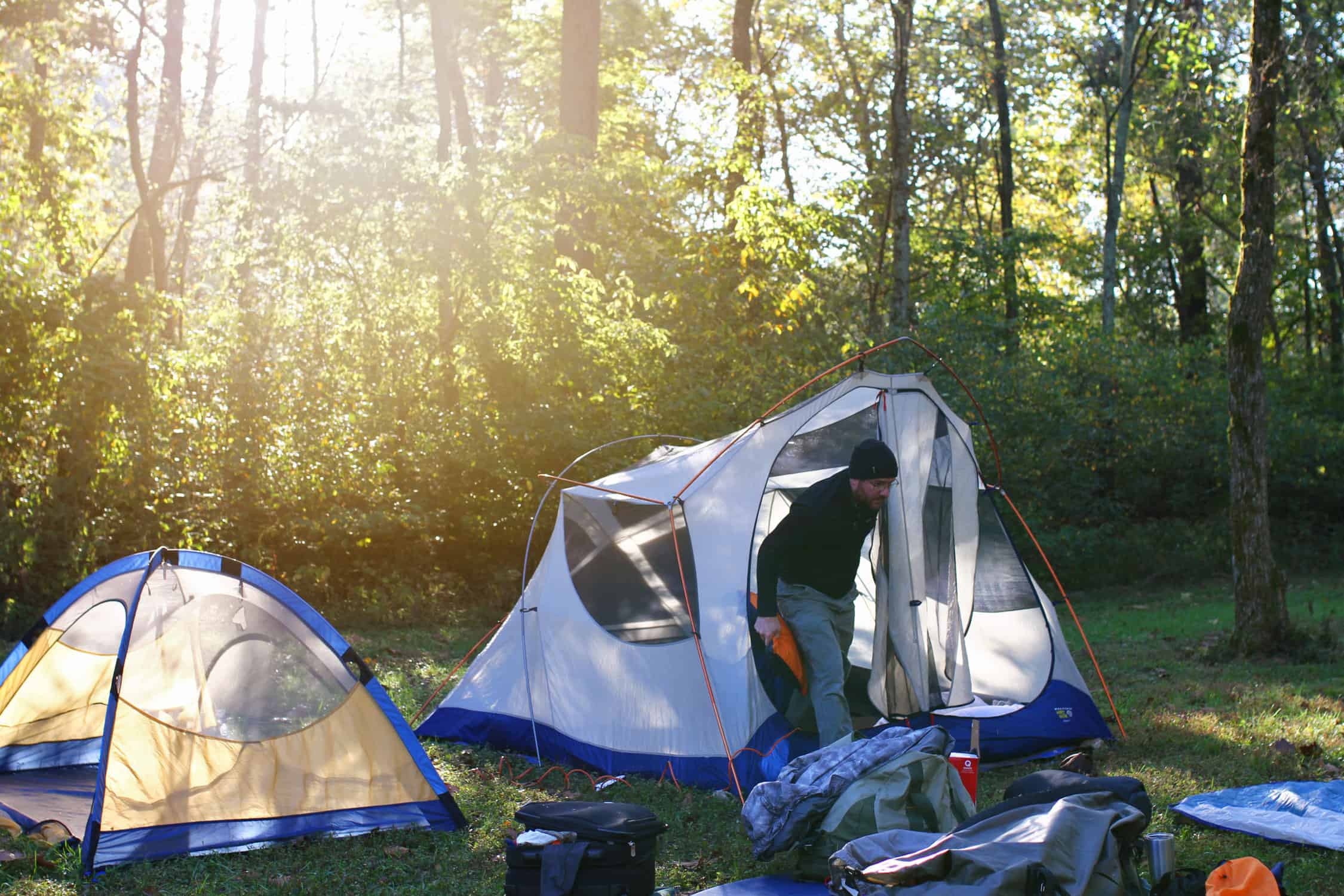
Books
Hopefully, you will do some relaxing on your trip, and what’s better than sitting down with a good book? Scroll down below for some great kids camping books for kids.
Games
Bubbles, chalk, jump ropes, frisbee, card games like UNO or Skip-Bo, activity books, board games, sketch pads, fishing gear, and bicycles with helmets are all options for your family to bring for some entertainment.
Outdoor string lights
Solar powered string lights can add extra light and ambiance to your tent or even your whole campsite. They make your whole campsite feel a bit more magical!
Bluetooth speaker
Bring a waterproof Bluetooth speaker with you if you want to listen to some music while camping.
Hammock
These are not necessary unless this is your chosen method for sleeping, but they can be fun and relaxing. Many kinds are easy to pack away and lightweight while still sturdy. A hammock can easily provide my kids with hours of fun and entertainment. If your kids are anything like mine, a hammock can become a swing, a fort, or the perfect spot to ask mom for a gazillionth snack. Whatever way your kids prefer to make use of this classic camp item, you can’t go wrong with something like the ENO SingleNest Hammock.
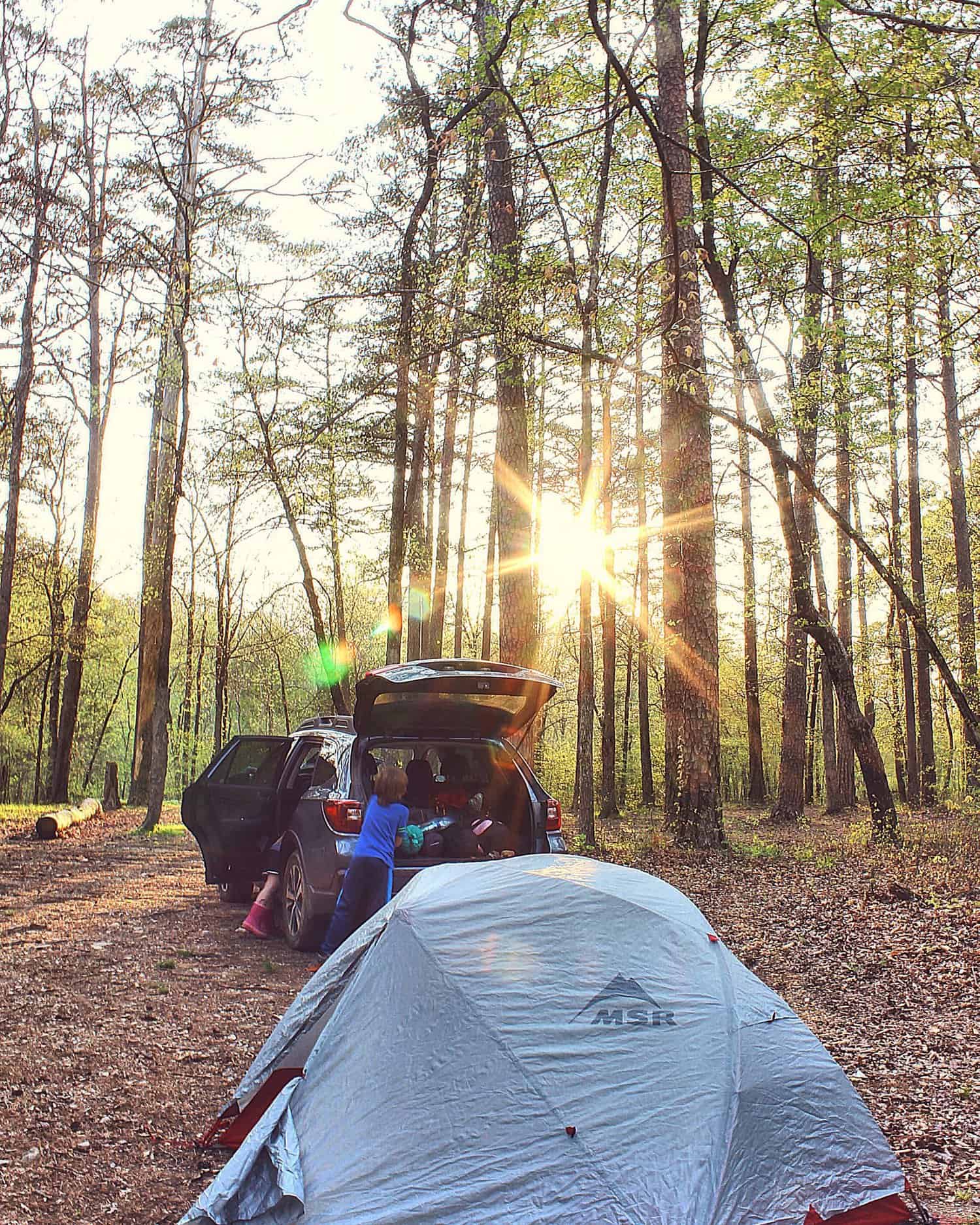 Photo credit: @coleyraeh
Photo credit: @coleyraeh
Helpful extras to add to your camping gear list
- Trash bags
- Ziplock/stasher bags
- Duct tape
- Zipties
- Batteries
- Toolkit
- Portable potty
- Waterproofing spray
- Backpacks for day hikes or adventures
- Cash for the camp store
- Clothespins and a clothesline (we used this one, but a rope works well too!)
- Phone chargers
- Broom
- Camera
- Utility gloves
- Hatchet/saw
- Beach blanket
- Extension cord
- Koozies
- Tent repair kit
- Extra tent stakes
- Rubber mallet
- Fly swatter
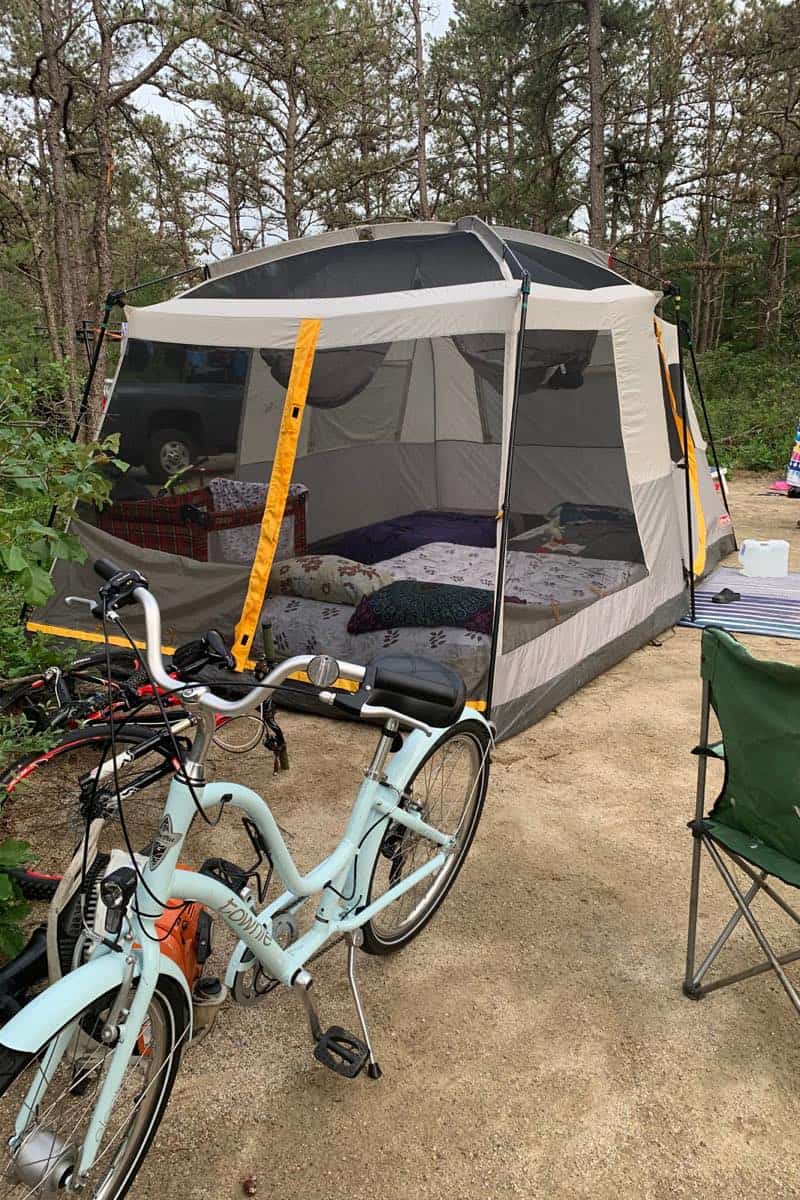
How to store your camping gear
Now that you’ve got a good grasp on everything you may ever need to bring with you when camping, what do you do with all that gear after your epic camping trip with your family? Make your life easier by staying organized for your next camping trip, with a few of these solutions.
Clear bins
Clear bins work really well for storing camping items. You can see all or most of the contents from the outside, if you are ever unsure of what is on the inside. Each bin can be labeled on the outside with the gear it contains, or you could even keep a master list inside the container of all the contents. This will help you make sure that things are returned to the appropriate bin and restocked when necessary.
For example, a bin with kitchen items, another for lanterns, flashlights, and string lights, a container with bedding, sleeping bags, sheets, etc. Store these bins in an out-of-the-way place like your basement, attic, or garage. If you plan correctly, you will have perfectly packed bins ready for your next adventure, making it that much easier to go camping!
Pegboards
Pegboards are great to hang in garages, storage closets, and basements. These are highly-functional and really helpful when hanging all kinds of items such as backpacks, headlamps, axes, hydration bladders, and even sleeping bags. Pegboards are great use of space when you are already short on space.
How to store your tent
Make sure that your tent is completely dry before storing, and don’t store it in a cramped or tight space. If it’s too tight, it can put unnecessary tension and stress on your tent fabric and poles. Your tent should be stored loosely in a cool dry place. Consider rolling the tent up and placing it inside of a large pillowcase. Avoid folding it, packing it up too tightly, or packing it in hot or humid places that can trap moisture inside.
How to store sleeping bags
If you’re low on storage space, sleeping bags can be rolled up and stored in their original bags or inside of pillowcases. However, if you have room, you could also hang them in a closet or on a pegboard. We store ours hanging from hooks in our dry attic.
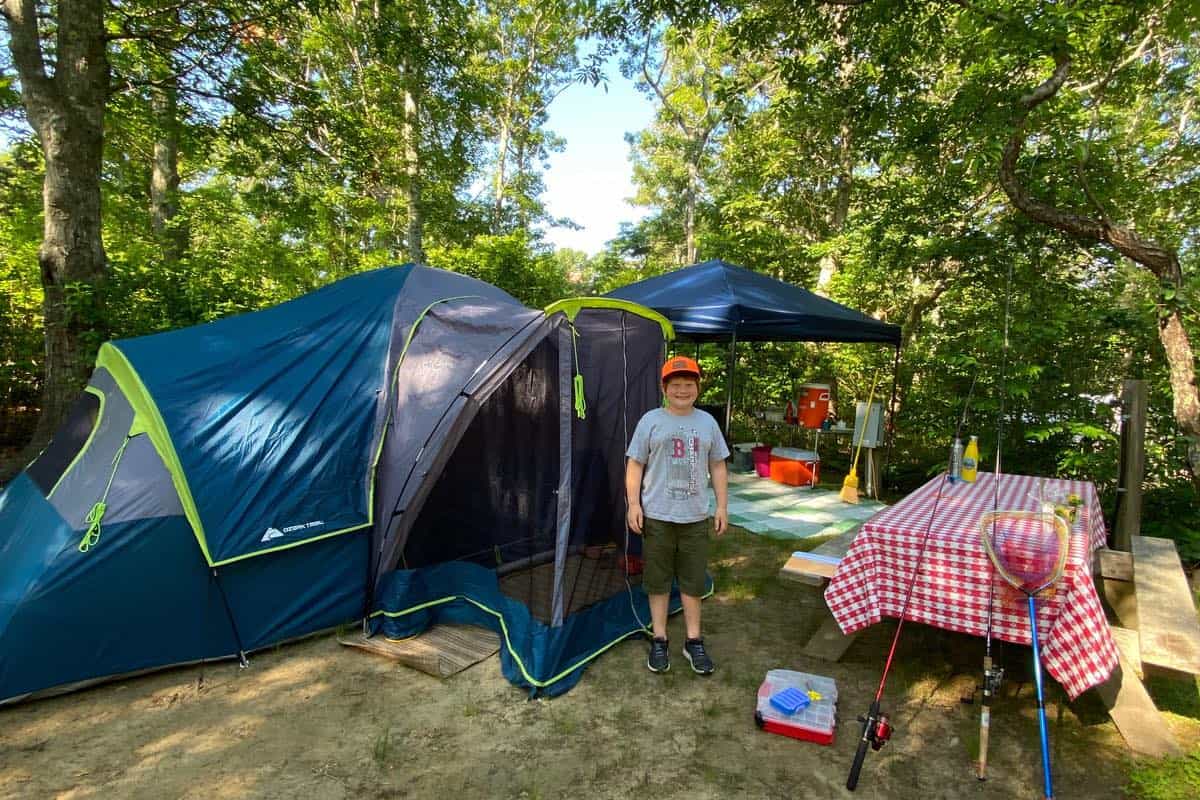
Camping books for kids
One of my favorite camping activities is relaxing with a good book. Here are some camping-themed children’s books you can add to your camping gear list and bring along for your kids to enjoy!
- The Camping Trip by Jennifer Mann
- Llama Llama Loves Camping by Anna Dewdny
- Curious George Goes Camping by H. A. Rey
- When We Go Camping by Margruit Ruurs
- A Camping Spree with Mr. Magee by Chris Van Dusen
- The Little Book of Camping by Zack Bush
- Pete the Cat Goes Camping by James Dean
- Amelia Bedelia Goes Camping by Peggy Parish
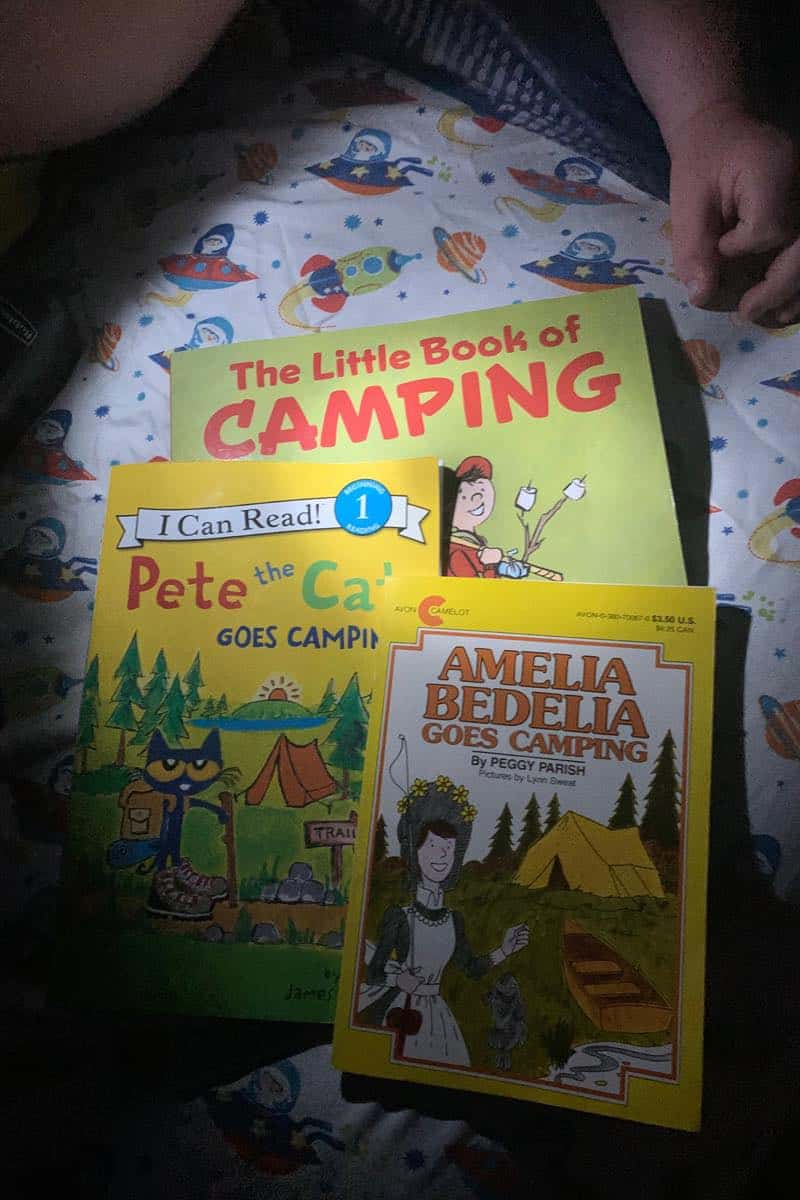
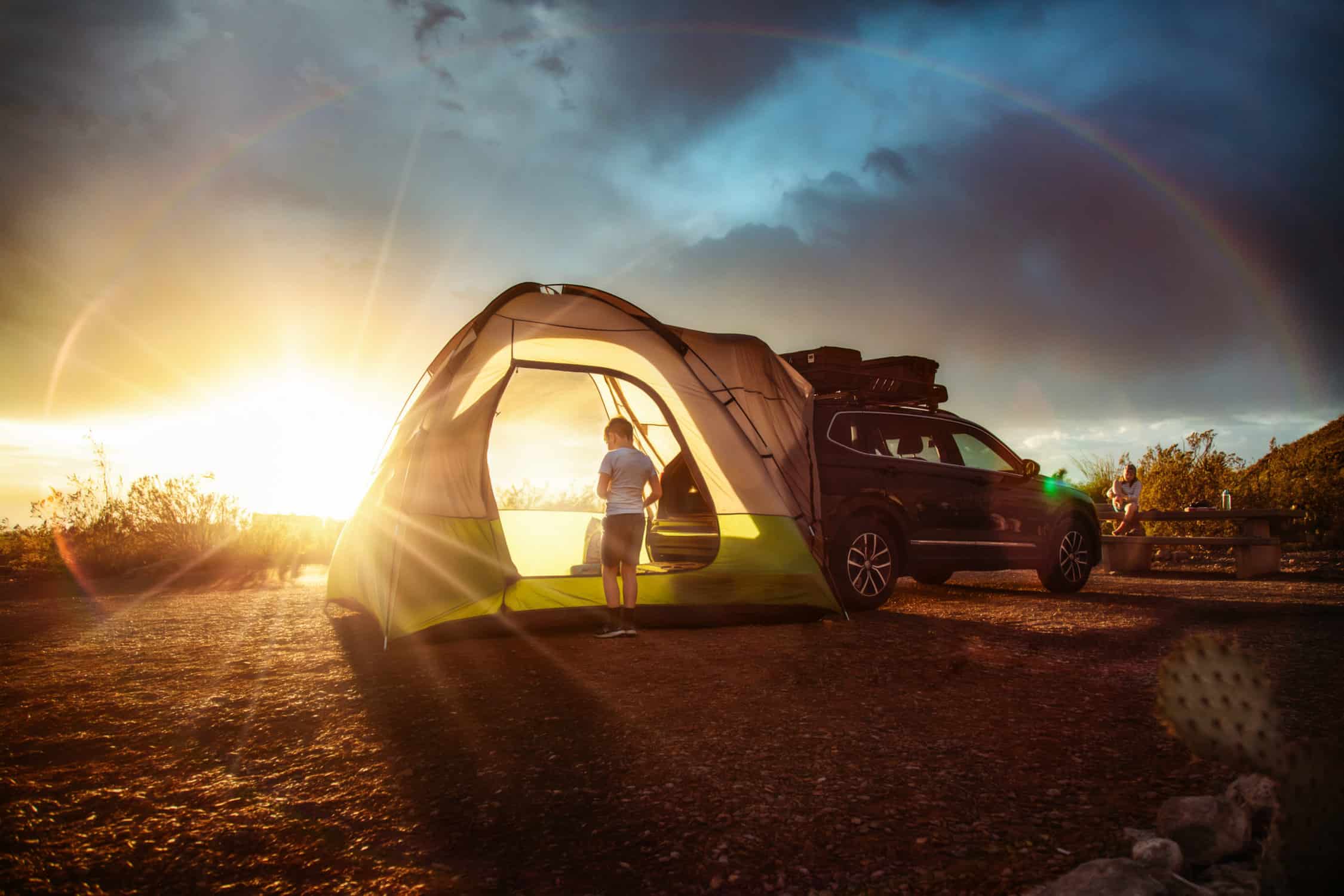 Photo credit: @kristcx
Photo credit: @kristcx
Additional camping resources
If you’re looking for even more info on how to camp with kids, we’ve got you covered. Check out these great camping resources below for your next camping adventure:
- Camp Like A Champ Digital Guide
- Beginner’s guide to camping with kids
- Overnight camping made simple
- Top Tips for backyard camping with kids
- Winter car camping
- Pop-up camping with kids
Printable camping gear lists for families
To make it easier for you to get started on your next family camping trip, we put our ultimate camping packing list for your family in a free printable 2-page PDF for you! Use this as the perfect start to create your own master packing list. You’ll also be signed up to receive our AMAZING weekly newsletter, filled with fun outdoor activities and inspiration for getting your kids and family outside! You can opt-out anytime (although we’d hate to see you go).
[maxbutton id=”1″ url=”https://mailchi.mp/6ad1ea8208c2/fw0osm9qnr” text=”PRINTABLE CAMPING GEAR LIST” ]
Happy camping!
What would you add to this camping list for families?
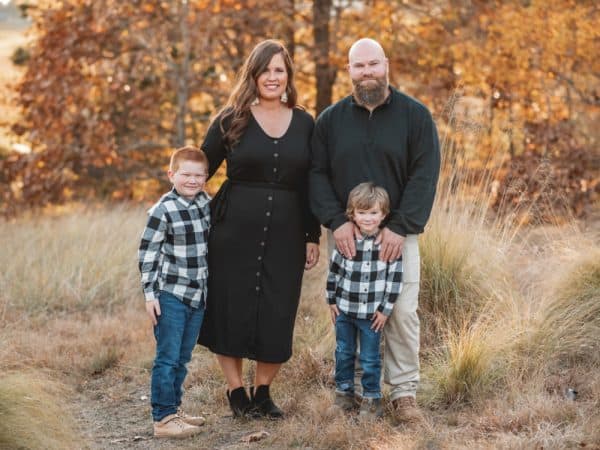
About the author
Lissy Perna lives near the ocean on Cape Cod, Massachusetts with her husband, 2 rambunctious boys (aged 4 & 7), and an ever-growing number of pets. She grew up walking nature trails and finding joy in the beauty of nature. She now shares that love for local adventures with her community through her blog, “Get Outside Cape Cod”. Lissy knows that everyone can benefit from spending more time outdoors, and wants to inspire and support families to do just that!
You can find more from Lissy in the following online locations:
Instagram: @getoutsidecapecod
Website: Get Outside Cape Cod
Facebook: @getoutsidecapecod
RWMC Posts: Lissy Perna
Comments
12 responses to “Ultimate Camping Gear List for Families”
[…] Ultimate camping gear packing list for families […]
[…] Ultimate camping gear packing list for families […]
[…] comfort level, your camping experience/skill, and tons of other factors. I highly recommend you start with our family camping gear checklist as inspiration, but make your own master copy of your camping packing list and update it with your family camping […]
[…] 18. Go camping – While most people probably go camping in the summer, we’re firmly in the fall camping camp. We love outdoor camping in the fall and prefer it so much more than summer camping (which is also great, don’t get me wrong). In the fall, there are fewer mosquitos, fewer campers, and the nights are cool and crisp for campfires and sleeping. The stars just seem brighter in fall, and the smell of the campfire is so much better! Hot coffee tastes amazing on a cool fall morning, and sleeping bags are snugglier. If you’ve never tried it, we’ve got a great post on how to get started camping with kids and our ultimate camping packing list for families. […]
This is an amazing and thorough list! Thanks for sharing! When we camp near our car, I also like to bring a little dustpan and brush to help sweep out the tent. Kids are messy and track lots into the tent, even with a rug. (My husband doesn’t love to bring this, but I do!)
[…] Image credit […]
great! very much appreciated for sharing this.
[…] Not sure what to pack for your next trip? Check out this starter list! […]
[…] Bring kid-friendly camping gear, such as portable chairs and outdoor games. Remember essentials like sunscreen, insect repellent, and first aid supplies. […]
Do you do drop shipping? I am opening up a new website that sells camping material and hiking tent, sleeping bags, that kind of stuff..
We should have the website up in 7 or 8 days.
Thank You[…] Not sure what to pack for your next trip? Check Out This Starter List! […]
[…] With these cooking essentials, your family can enjoy warm meals and snacks, which are central to a satisfying camping experience. Check out this comprehensive list of camping gear for families for more ideas: Ultimate Camping Gear List for Families. […]

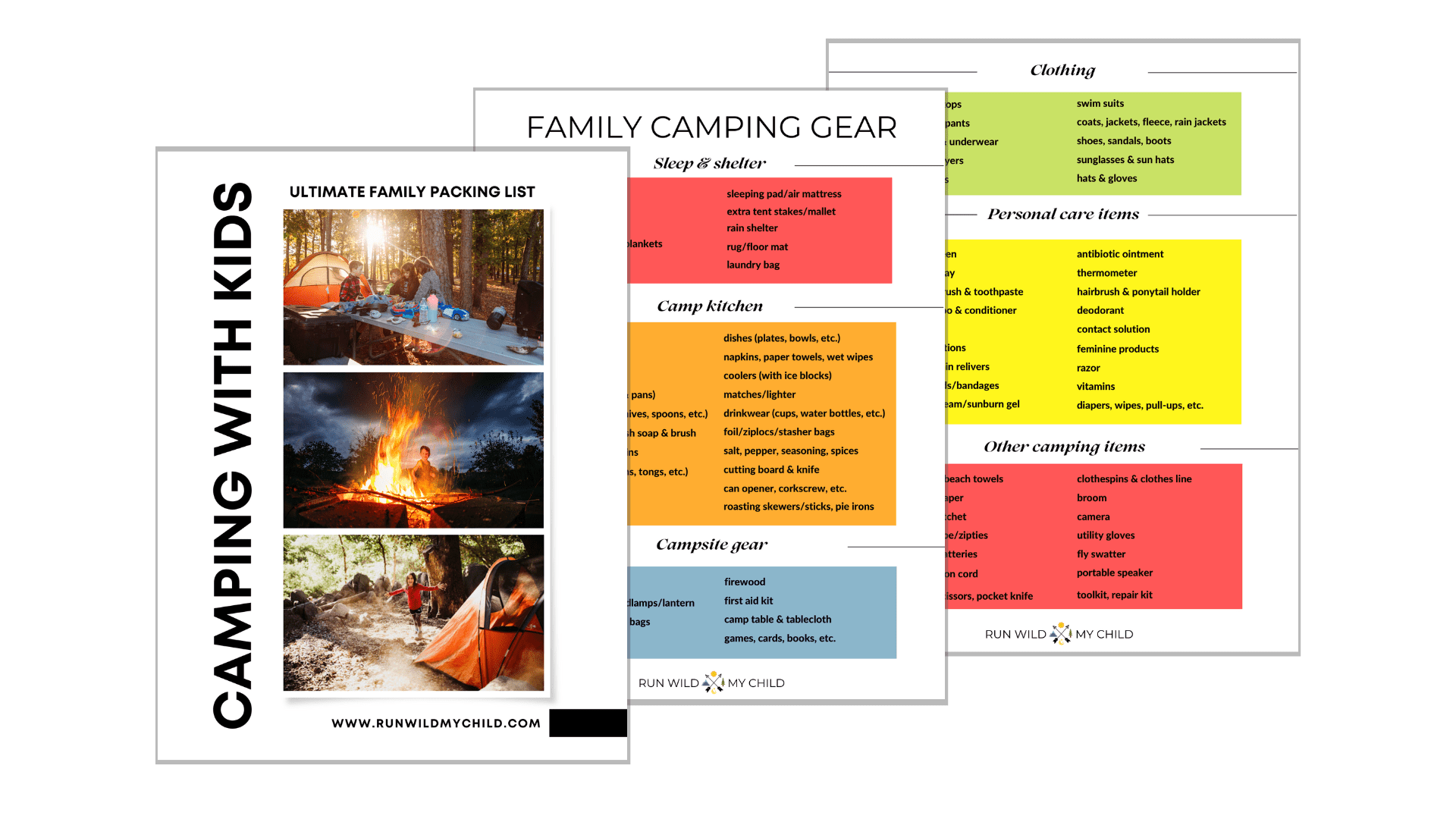
Leave a Reply